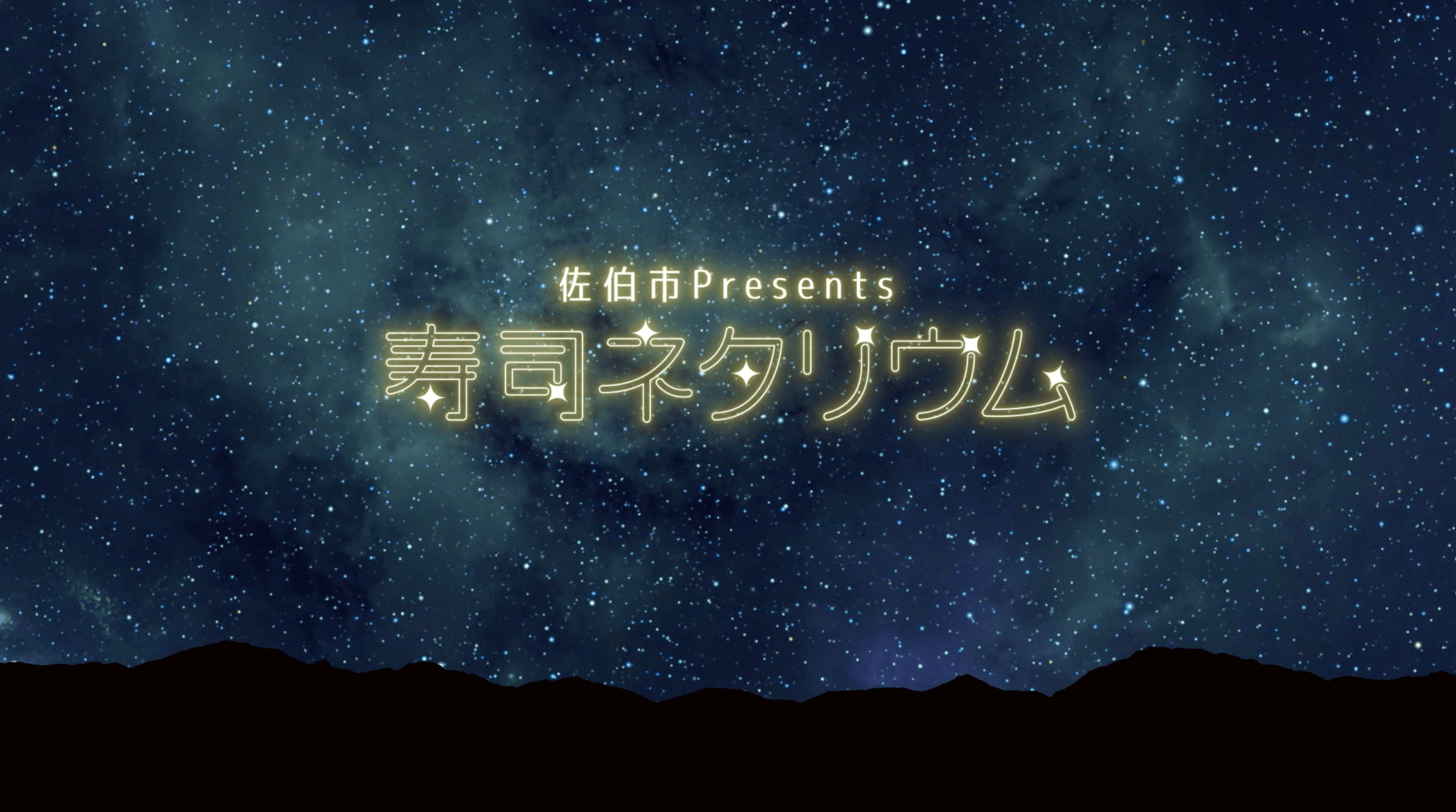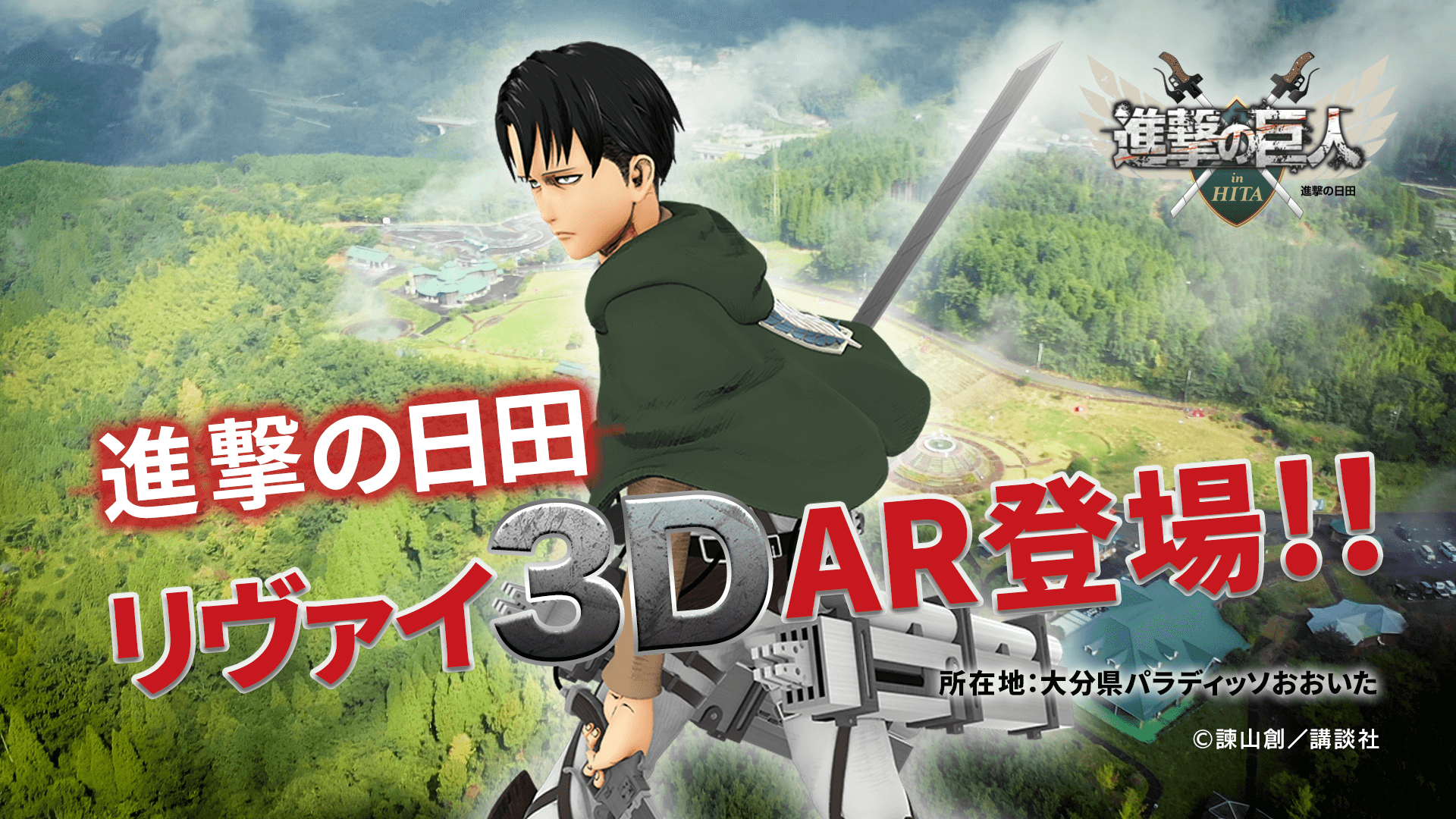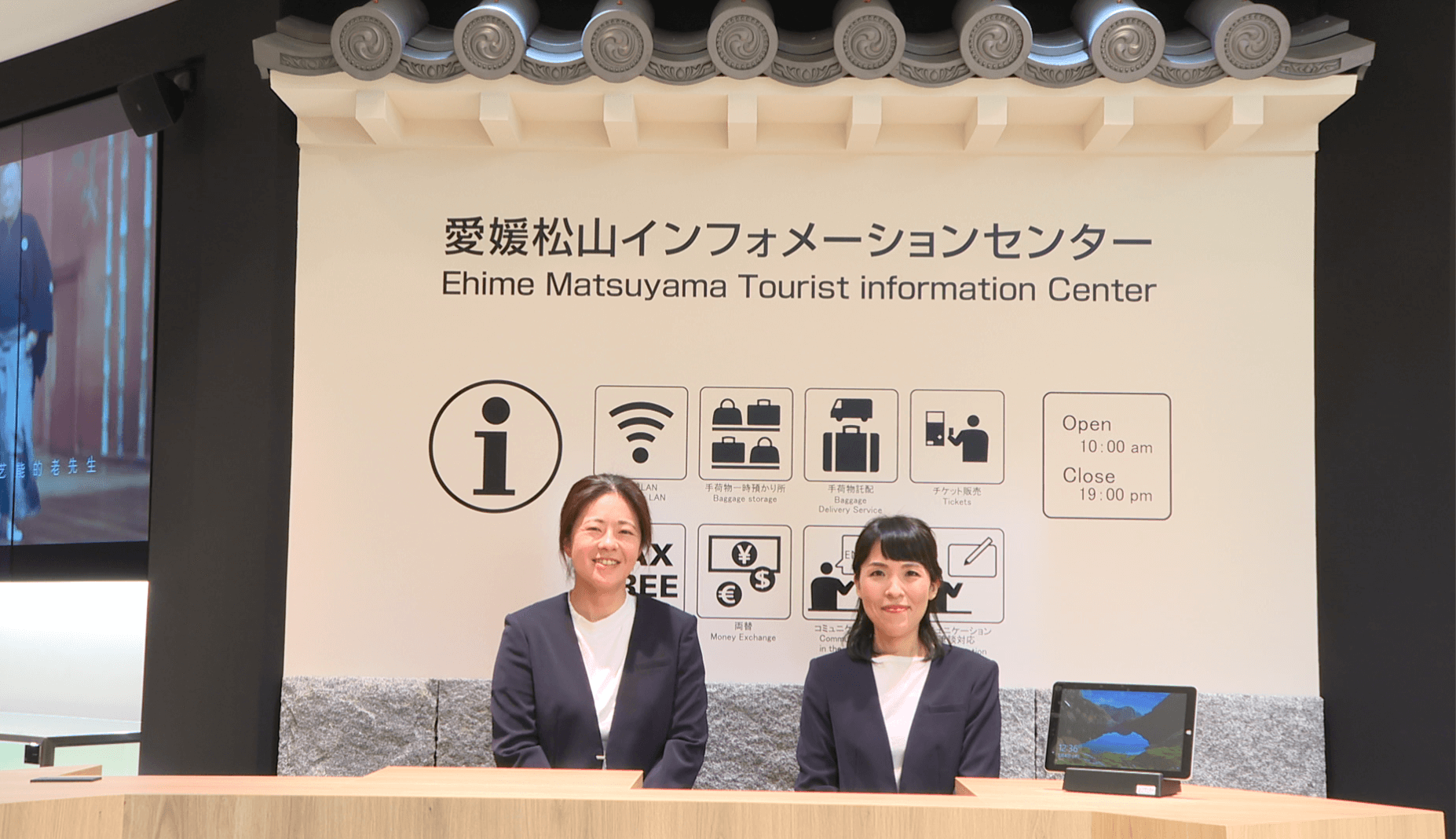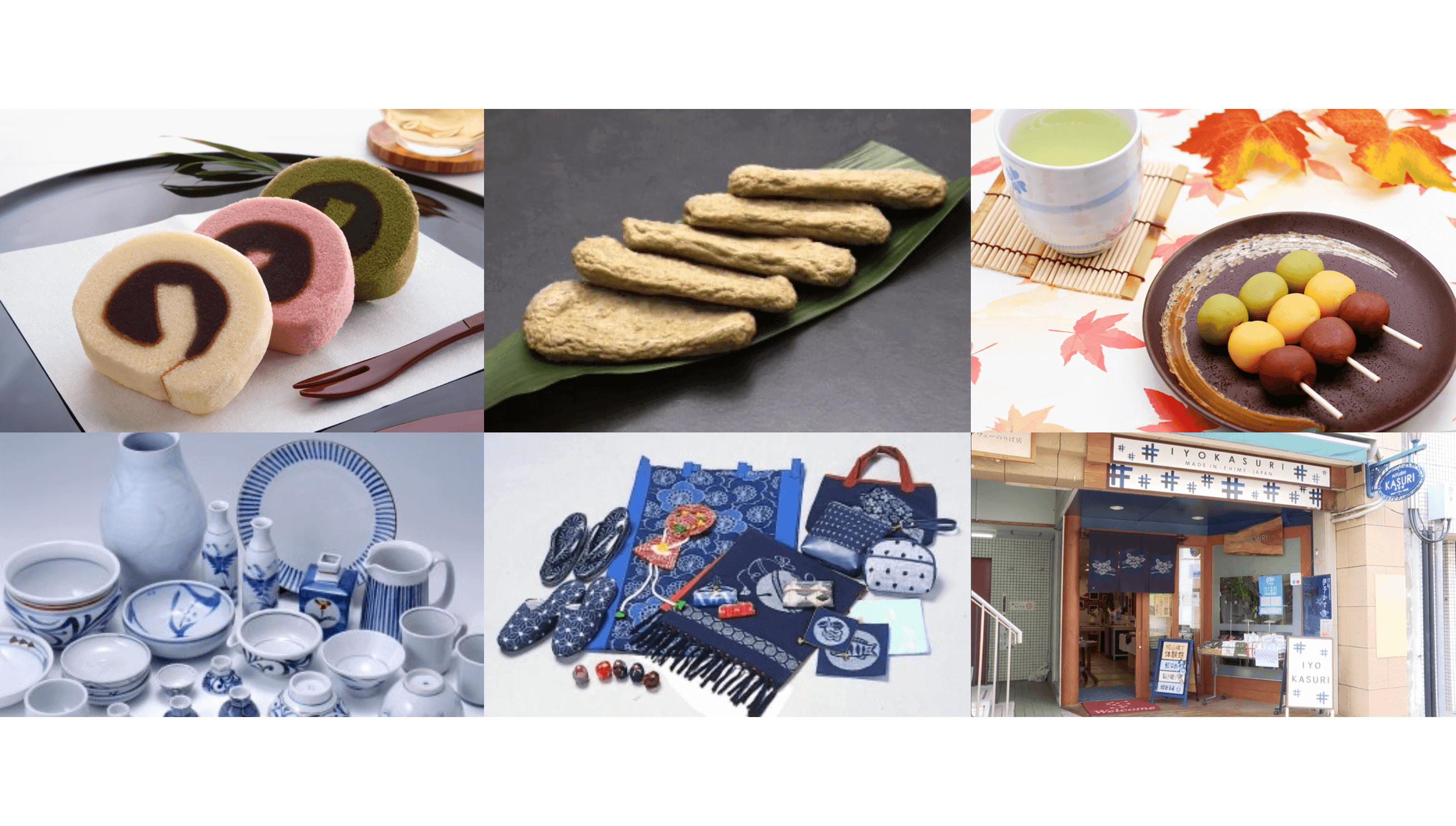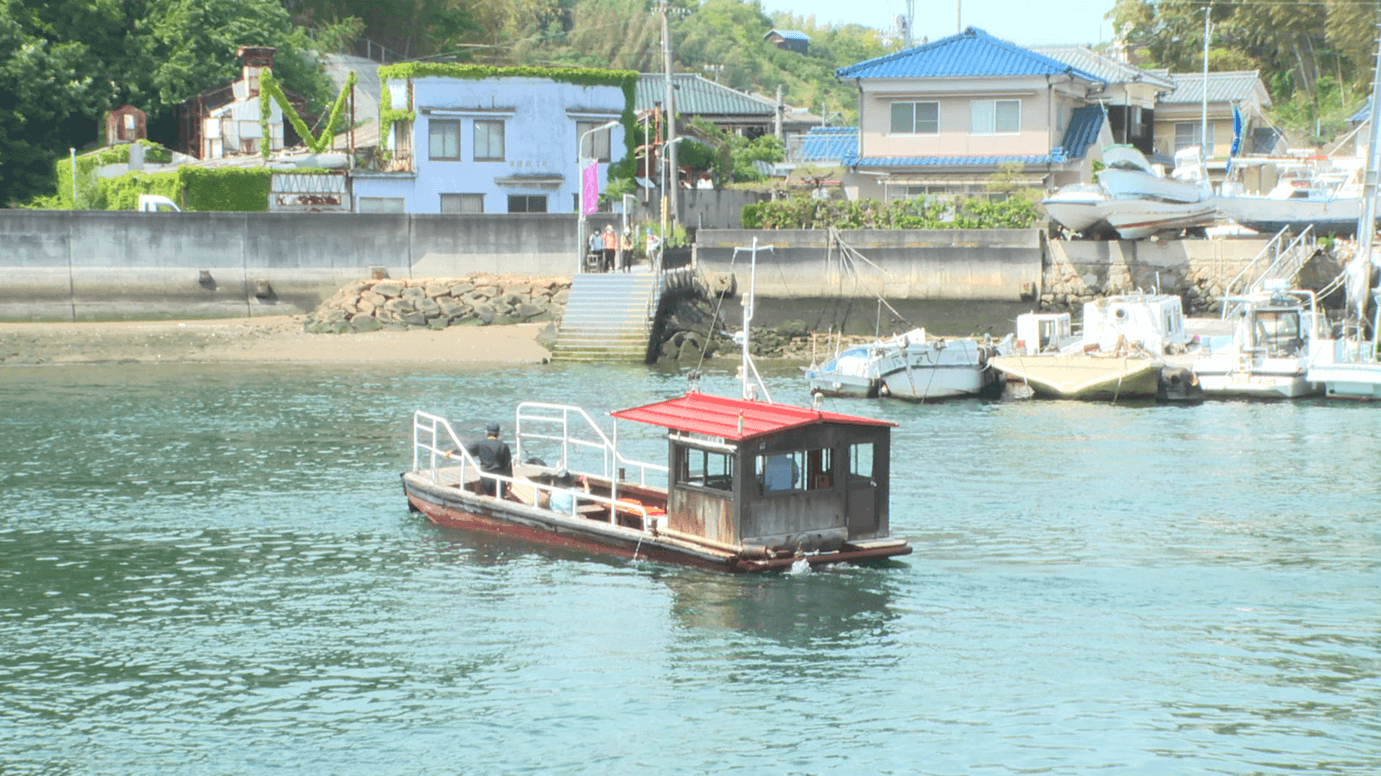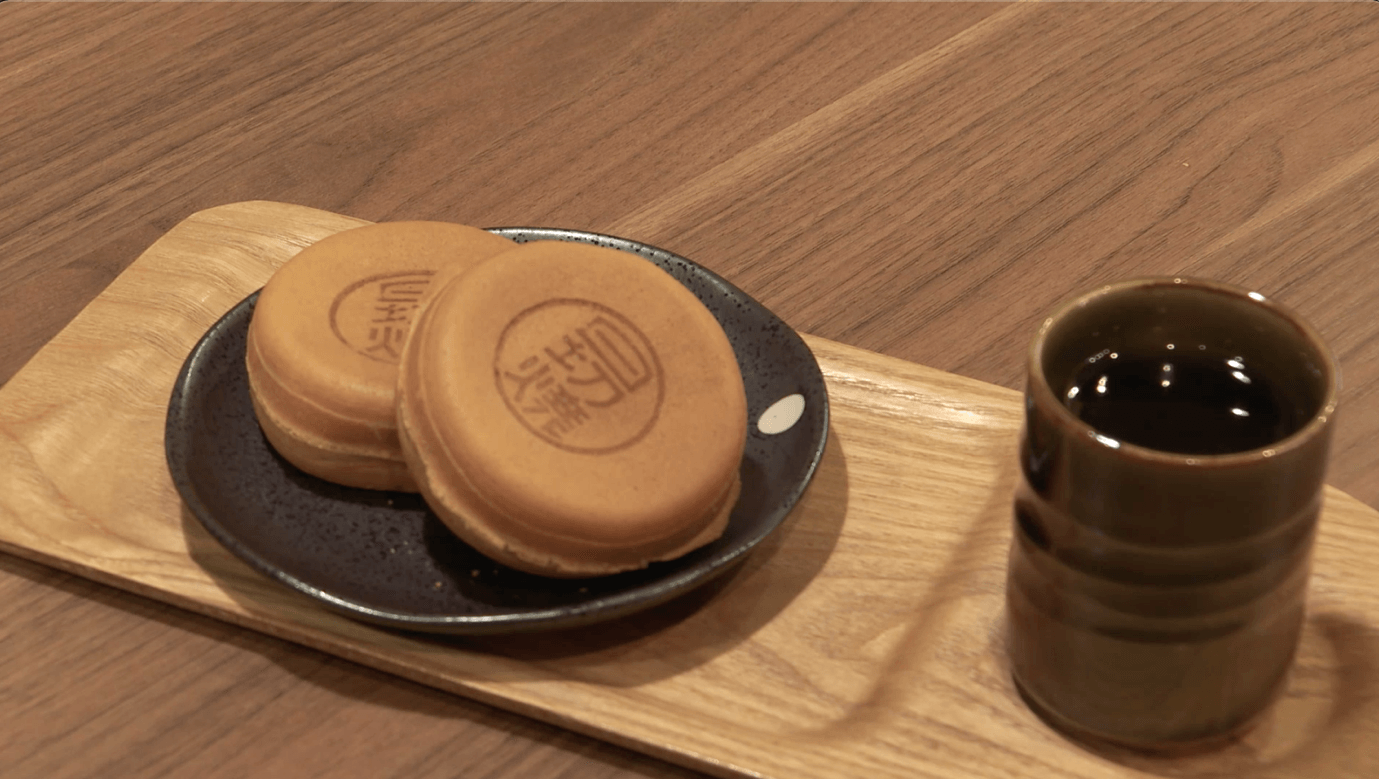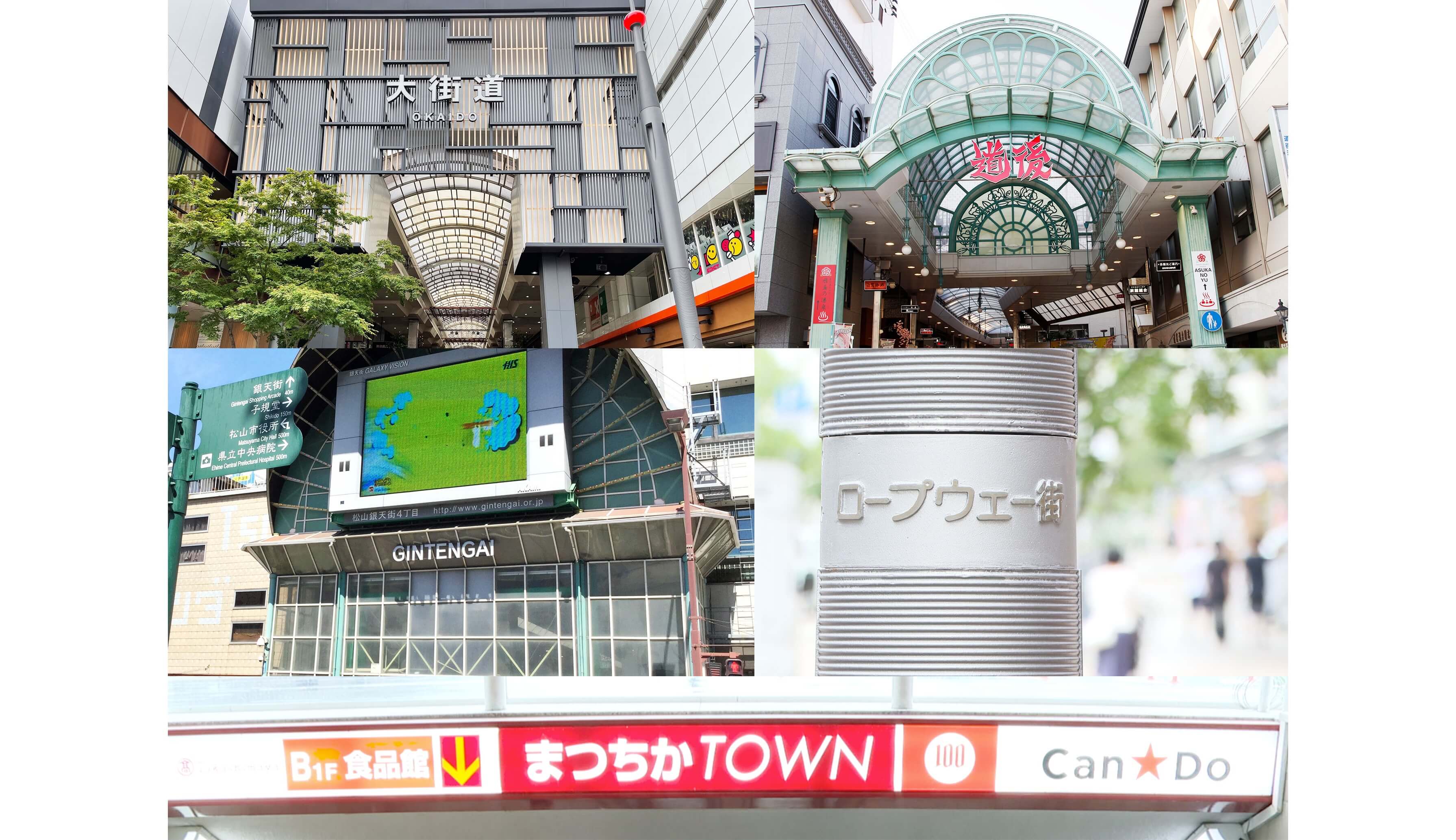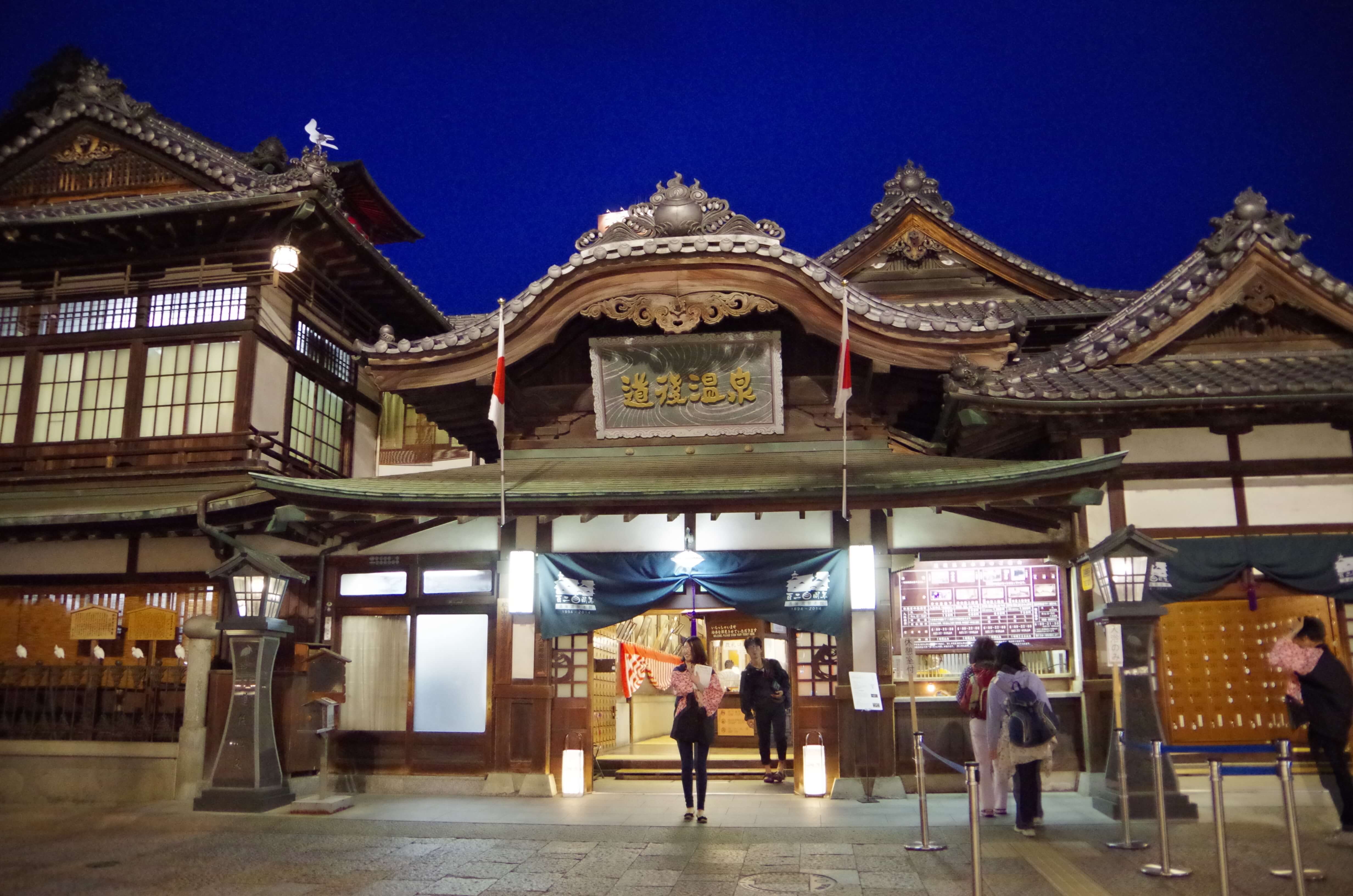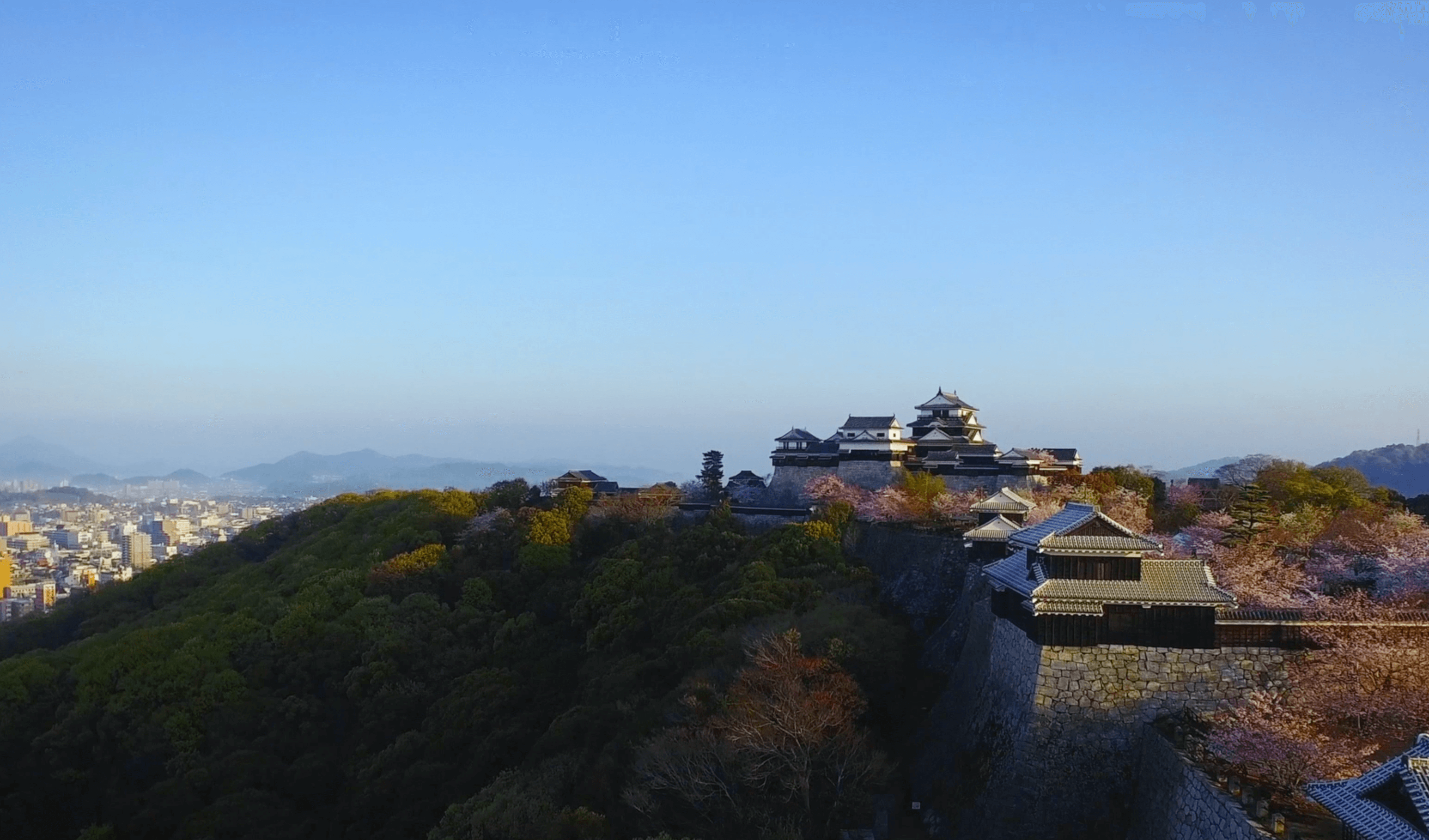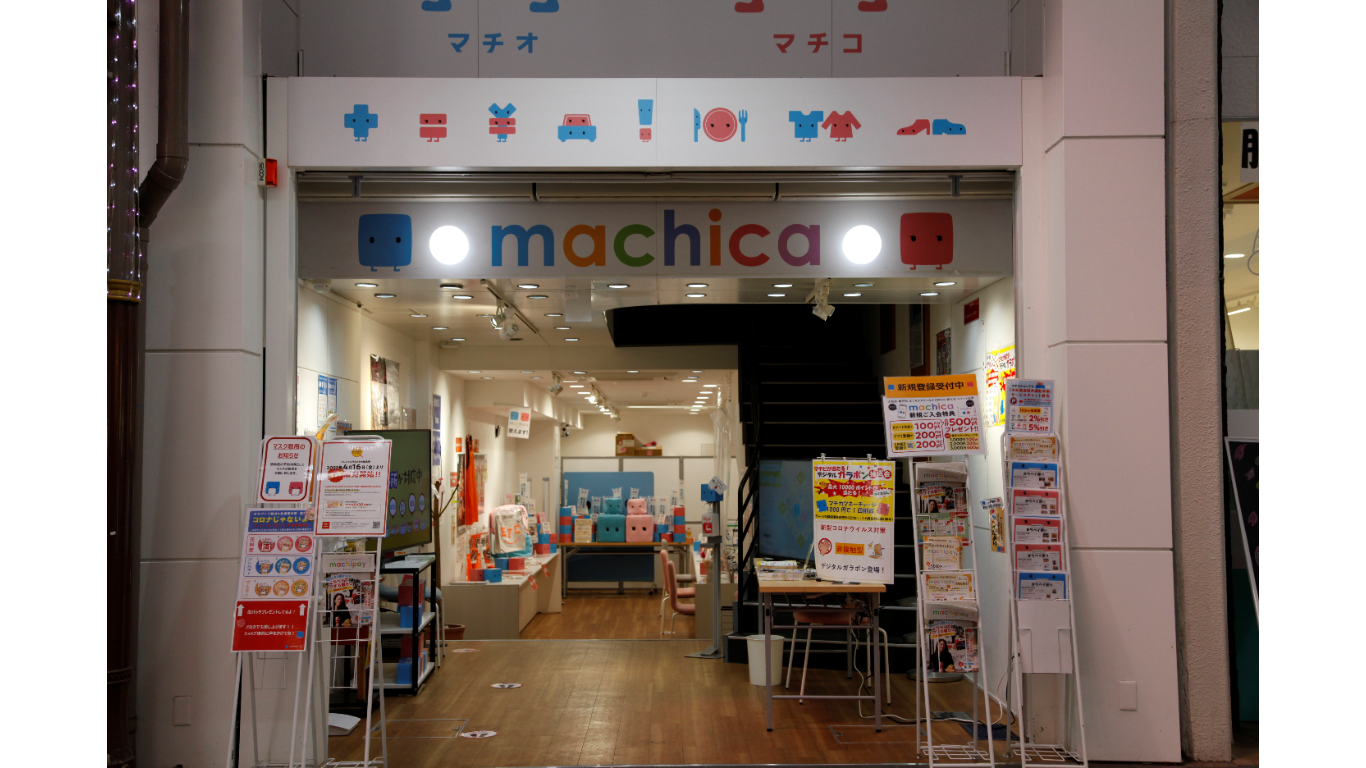Oita Prefecture is Kyushu is known as having the most hot spring sources and yield in Japan. Places in Oita such as the city of Beppu and town of Yufuin are highlighted as some of the most famous hot spring sites in Japan and enjoy an influx of tourists every year, but their appeal doesn’t stop at hot springs. Oita will host this year’s Rugby World Cup, and because of that, the prefectural government is putting more efforts into dining, speciality products and spreading tourist and sightseeing information.
Let’s take a look at some of the must-see sites, art and culture of the prefecture.
InterContinental ANA Beppu Resort & Spa
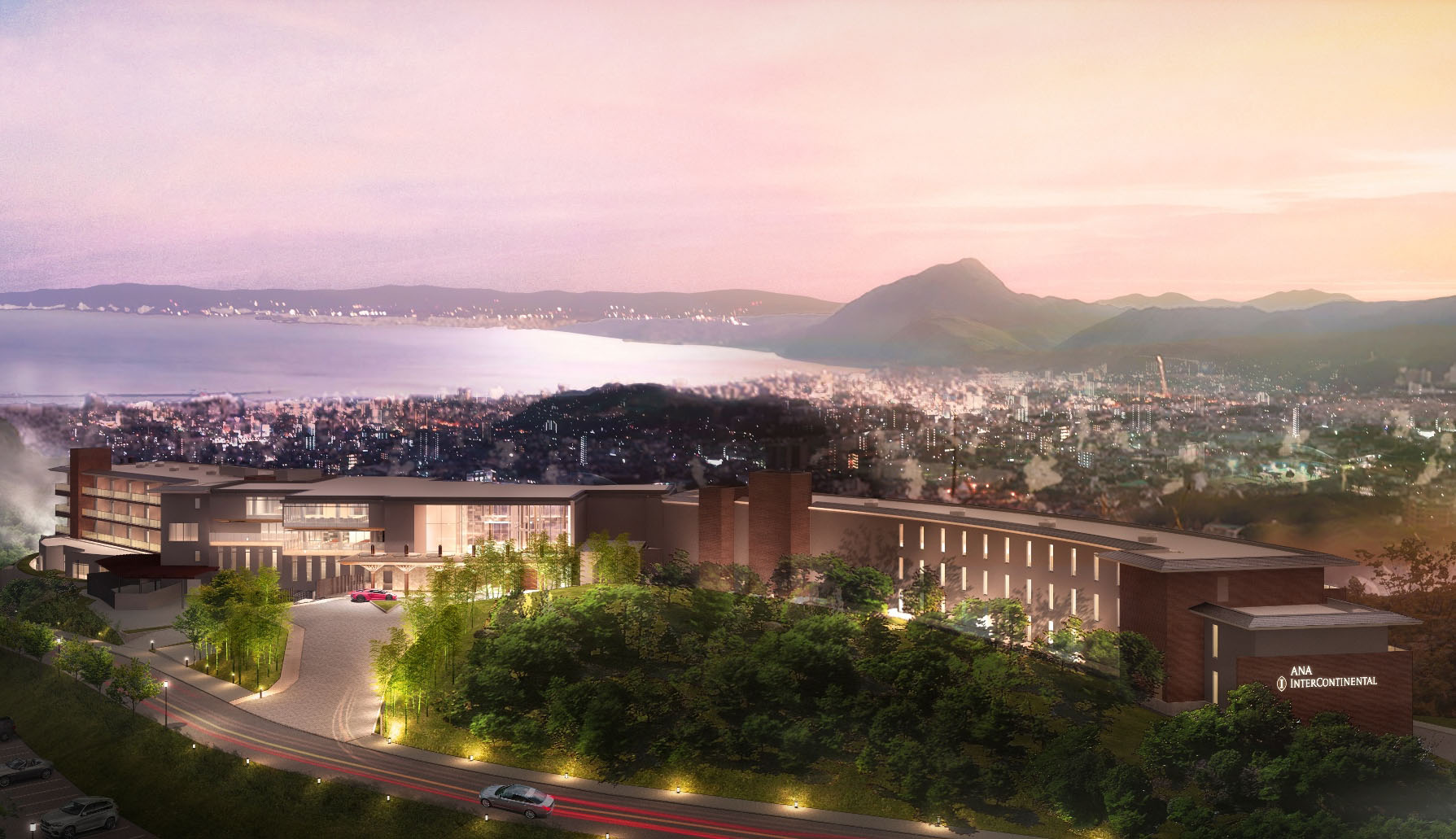
InterContinental ANA Beppu Resort & Spa is Oita’s first foreign-owned luxury brand hotel set to open this year on August 1. This resort-style hotel will combine Beppu’s status as Japan’s spearhead of hot springs with the concept of an intercontinental brand hotel to offer the ultimate relaxation and healing.
There are 89 rooms at the hotel which incorporate the strenuous craft and expertise of local artists and artisans such as bamboo work. The rooms span 62-212m2 and are decked out with interiors made with natural materials and enjoy presentations perfect for those seeking peace and tranquillity. 21 of the rooms are suites and club rooms each with terraces equipped with private open-air baths. And if you make use of the Club Intercontinental Lounge you can enjoy top class service.
Guests can enjoy the rich spring water of Beppu in both the open-air baths and public baths. Not only is there a spa there’s even an infinity pool from which guests can enjoy a gorgeous view.
Official Website: https://anaicbeppu.com/en/
Ryumon Falls (Kokonoe)
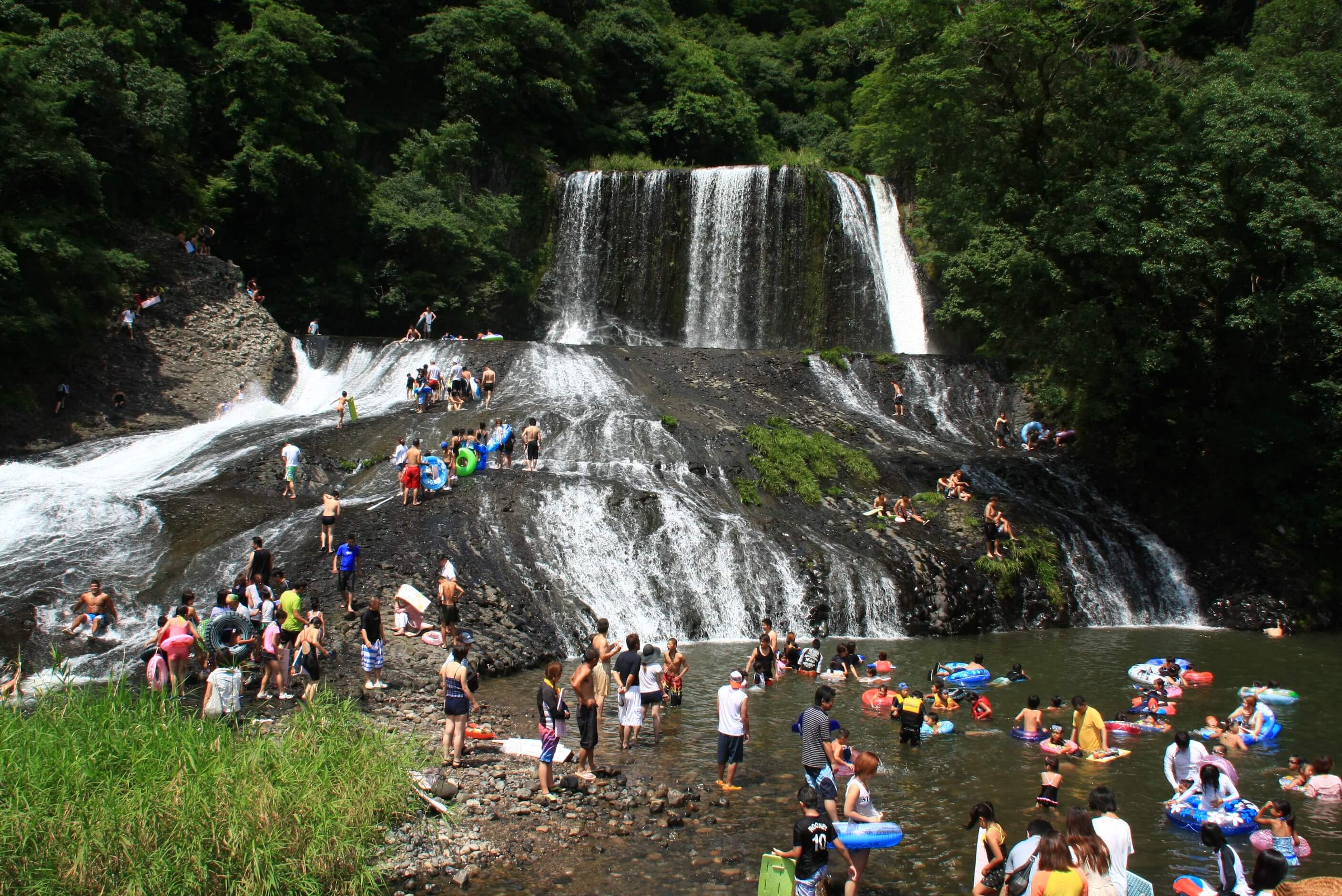
Ryumon Falls is a 26-meter waterfall spanning 40-meters wide. The waterfall itself runs down the rocks below it, almost creating a second waterfall. In summer, kids and adults alike both enjoy the thrill of using it as a water slide. During the summer season, the camp sites, diners and souvenir shops bustle with tourists. You can pick up a mat and other items required to slide down the rocky slope in the surrounding area.
Address: Matsugi, Kokonoe-machi, Kusu-gun 879-4632, Oita Prefecture
Traditional Crafts at Nakatsu Castle Shitamachi – Shuka’s Japanese Umbrellas
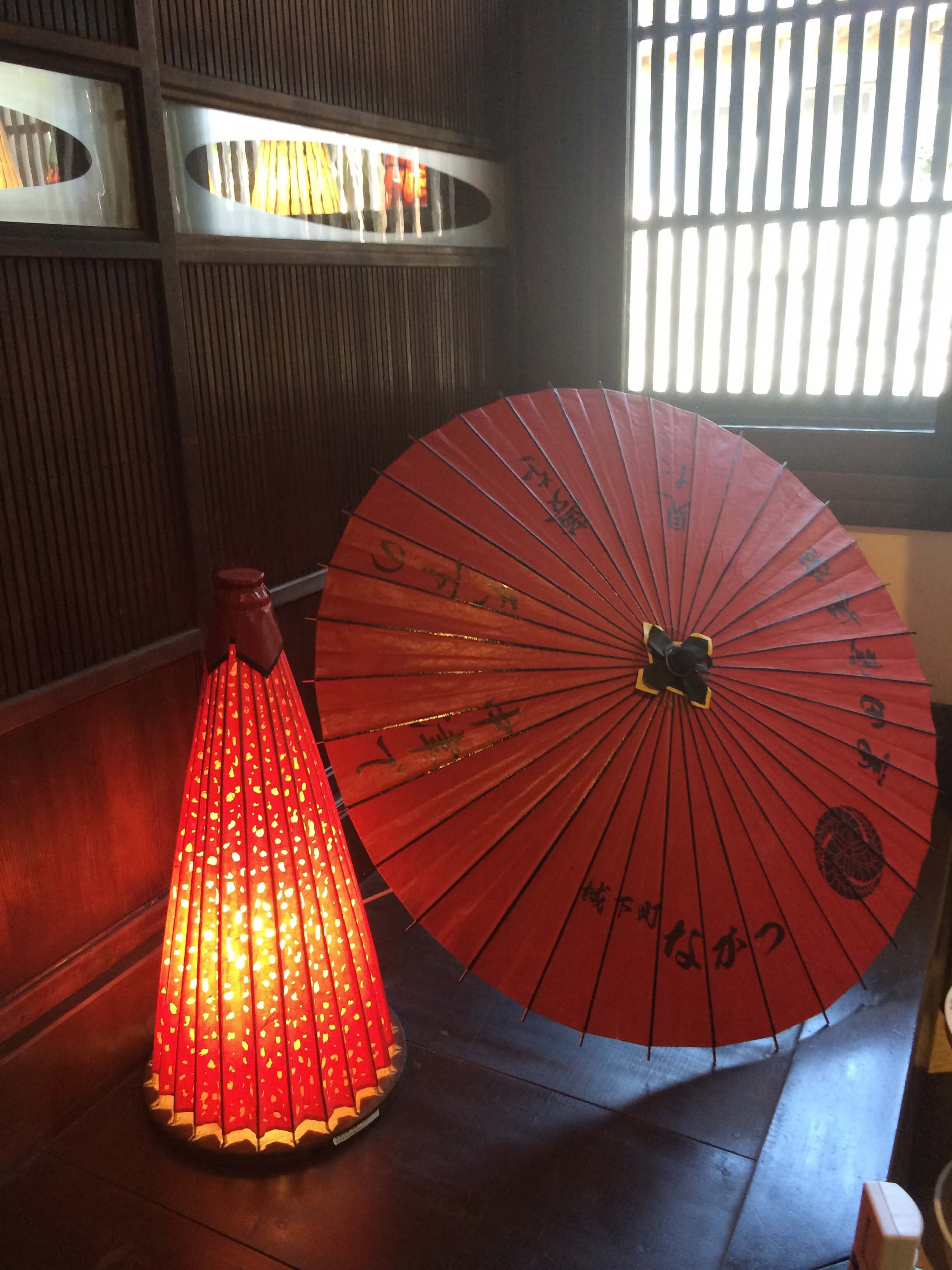
During Japan’s economic crisis at the turn of the 19th century, policies were enacted that encouraged areas to create their own speciality products. This sparked the manufacturing and selling of umbrellas which were made from bamboo, Japanese paper, oil, astringent and other materials all sourced locally. The early Showa period was the golden age for Japanese umbrella production, but it later declined and production eventually stopped in 2003 due to the ageing of the craftsmen who made them. However, production restarted in 2005 by Shuka to help revitalise the traditional Japanese craft of creating umbrellas. Since then, the same production methods that were used back in the day have been adhered to, and new designs have come to life. They are now back in fashion and growing in popularity.
Official Website: http://shu-ka.jp/
Michi no Eki Innai
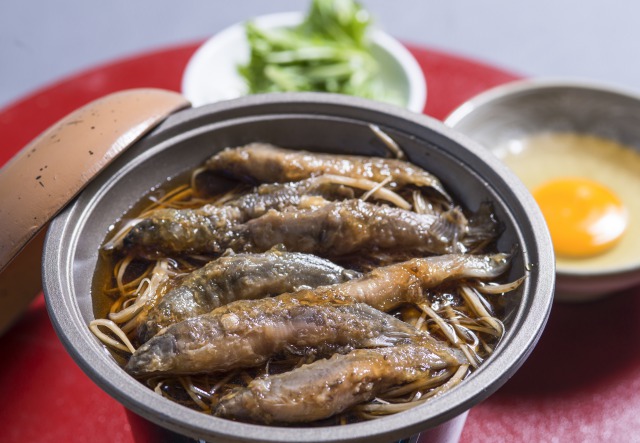
Michi no Eki Innai is located in the centre of Innaimachi Kushino, a town home to the only village in Japan built on a stone bridge. They sell a variety of food products including speciality food items, including a range of loach dishes such as fried loach and loach hot pot. They also have information on the stone bridge itself, and visitors can see a Japanese giant salamander up close. Their Usa Karaage is a favourable dish amongst visitors.
Official Website: https://www.michinoeki-innai.net/
Oita Prefecture is home to many fun and exciting spots and events, so be sure to explore if you’re planning a visit.
Information
Oita Prefectural Government Website: http://www.pref.oita.jp/
RELATED ENTRIES
-
[Channel47] Inbound Travel Product Allowing Visitors to Experience the “Real Japanese Countryside” in Iida, Nagano Prefecture Now on Sale
As part of the ongoing Channel47 project, which uses the power of local resources and entertainment to share Japan and its local culture with the world, a new travel experience titled ‘DEEP EXPERIENCE THE INAKA -TENRYUKYO・IIDA CITY-’ is now on sale, taking visitors to Iida, Nagano Prefecture.
Iida City in Nagano Prefecture will be the location for the tour, with the city selected by the Japan Tourism Agency in 2024 for its ‘Project to Promote Expansion and Quality of Inbound Tourism by Providing Special Experiences for Visitors.’ The Minami Shinshu Tourism Bureau helped to create the tour for inbound travelers to experience the “real” Japanese countryside found in the Tenryu Gorge area of Iida City by funding farmhouse homestays in the area.
By creating a travel experience that takes advantage of the local resources of Tenryu Gorge in Iida City, we aim to promote sustainable tourism activities by communicating the charm of the region to people in both Japan and abroad, revitalizing local production, passing on traditional culture, and strengthening cooperation between local communities.







Information
■Tour Name
DEEP EXPERIENCE THE INAKA -TENRYUKYO・IIDA CITY-■Tour Summary
This is a special tour that allows inbound visitors to experience the traditional culture and beautiful landscapes of Minami-Shinshu. By participating, guests can leave the hustle and bustle of the big city behind, appreciating the true essence of Japan by spending time in the quiet region of Tenryukyo, Iida City, Nagano Prefecture.◼︎Main Points
・A Three-day, two-night all-inclusive tour departing from JR Toyohashi Station with time spent in the Tenryukyo area in Iida City, Nagano Prefecture
・An exclusive train car on the JR Iida Line
・Special snacks and drinks supervised by Yukimoto, a famous restaurant in Iida that was awarded Gold on Tabelog.
・Various experiences in nature in each of the four seasons (such as rafting on the Tenryu River, scenic sky walk, agriculture and livestock farming experiences, etc.)
・Experience traditional Japanese culture (mochi pounding, Fire Festival, Wayuraku, Ningyo Joururi, etc.)
・Stay in a farmhouse homestay to experience real life in the Japanese countryside◼︎Dates
① January 10-12, 2025
② January 12-14, 2025
③ January 17-19, 2025
④ January 19-21, 2025
⑤ January 24-26, 2025◼︎Optional Menu
Dinner at ‘Yukimoto’
*Courses and drinks are not included in the tour price.◼︎Details/Contact
Minami Shinshu Tourism Bureau Sales Page: https://www.mstb.jp/gentei/deepexperience_the_inaka/
Official Tour Instagram: https://www.instagram.com/inaka_tenryukyo/ -
New Planetarium Project in Oita Prefecture Highlights Sushi, Not Stars
30.September.2022 | SPOT
In Saiki City, located in the southernmost part of Oita Prefecture, visitors will find a unique project. For a limited time, guests can enjoy a sushi-netarium, where sushi–not stars–will be featured in the sky. Saiki City, where the event takes place, is a treasure trove of seafood thanks to the Bungo Channel and boasts the largest catch in Oita Prefecture. It’s also known as Oita’s premier sushi destination, with more than 350 varieties of ocean delicacies to enjoy each year. Saiki Sushi, made from fresh local fish, is known for its firm texture and for having just the right amount of fat. To promote this tasty dish throughout Japan, the interactive sushi-netarium promotion was created!
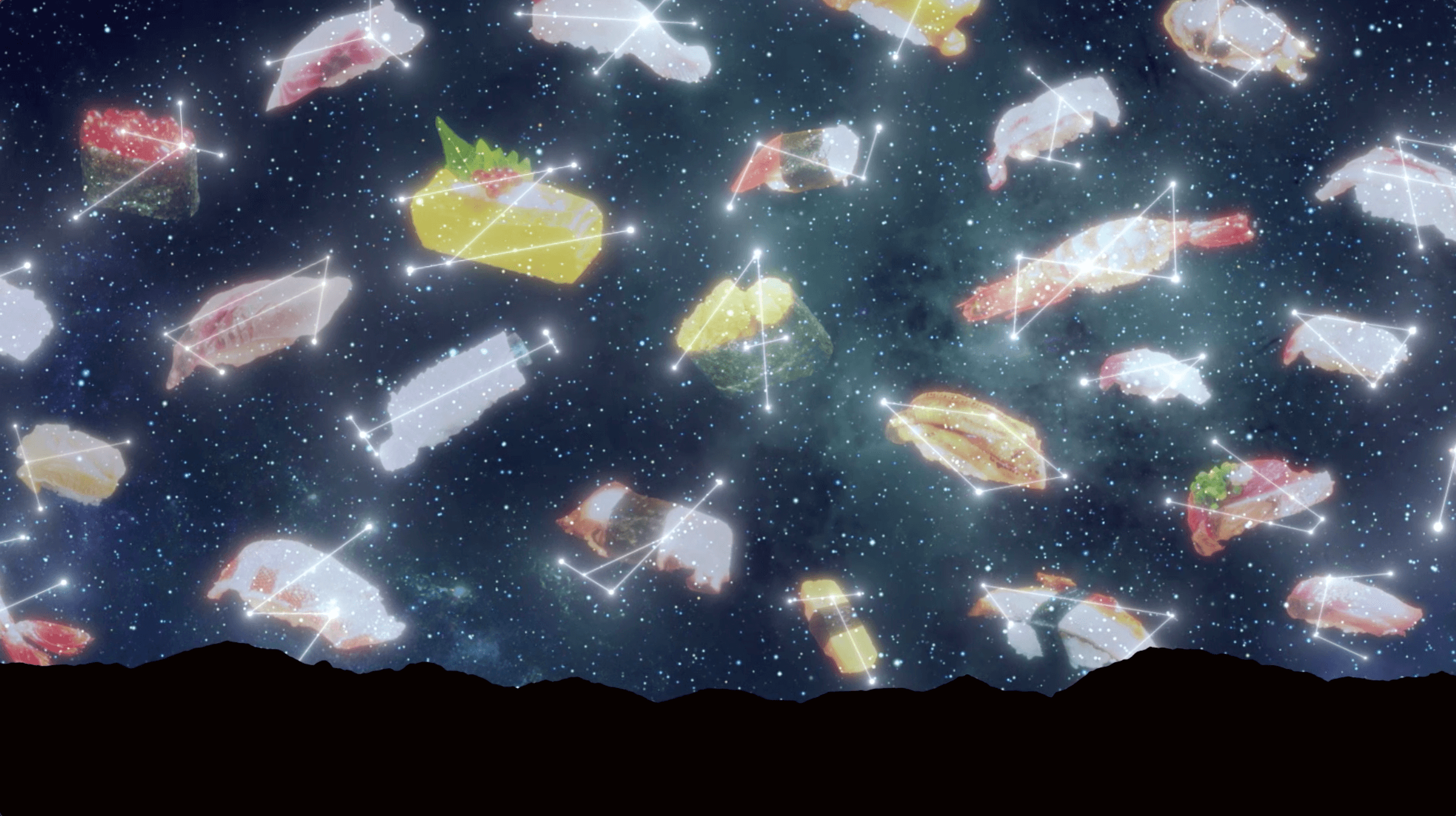
A Planetarium Experience Featuring Soothing Music and a Sky Filled with Sushi
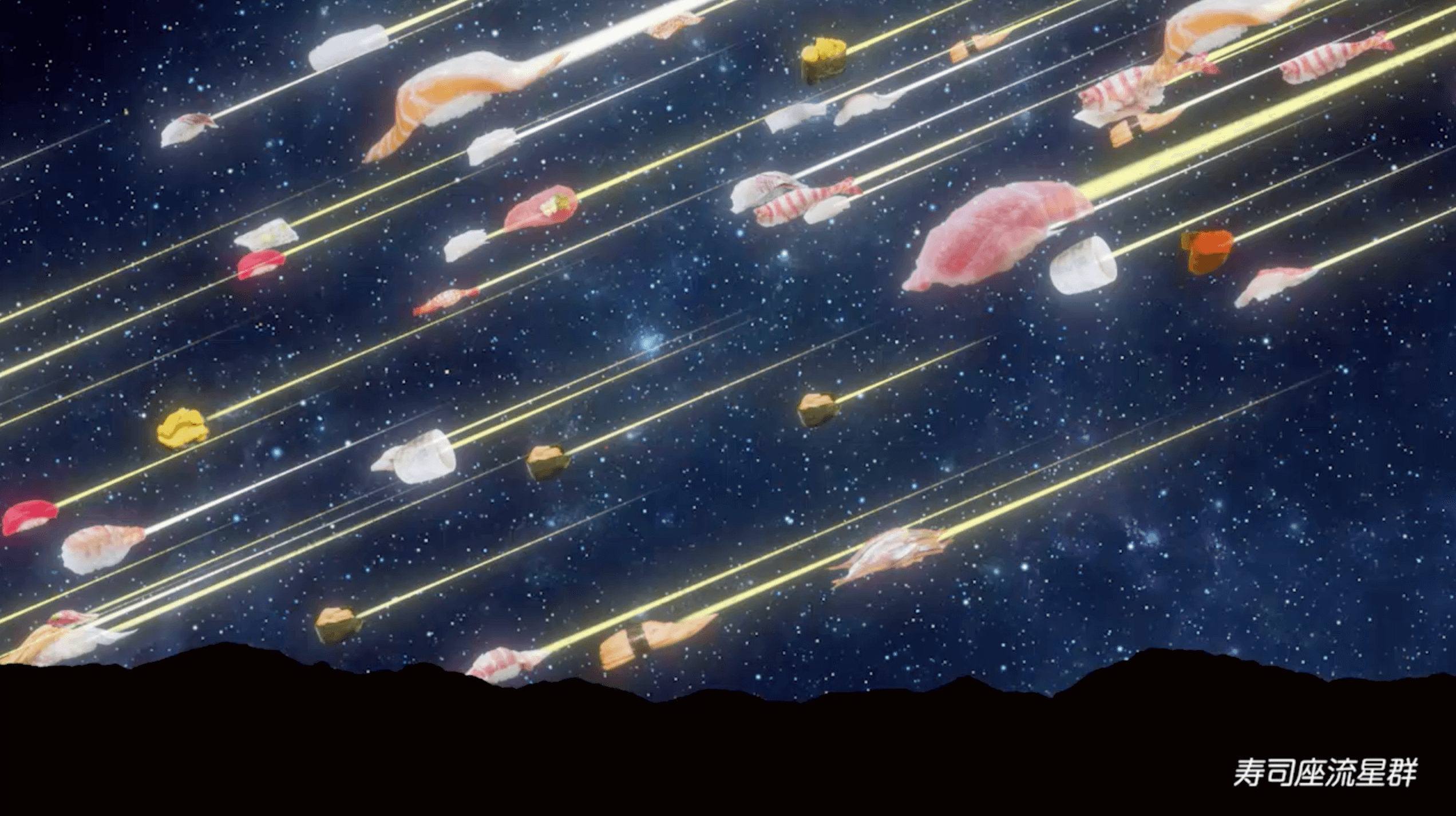
The sushi-netarium is said to have a relaxing effect comparable to that of Beppu Onsen, the most famous tourist attraction in Oita. Those taking part will be able to see not only a sky filled with sushi, but a sushi meteor shower and the Gari Borealis. As you watch, it might become impossible not to crave sushi! Visitors will be able to take part in this special viewing at certain locations in Beppu City and at Oita Airport from September 22 until November 30. In a public announcement, the city invited guests to eat plenty of tasty local food and soak in the Beppu Onsen before enjoying the sushi-netarium to wrap up a wonderful day.
The Beautiful ‘Sushi Projector’
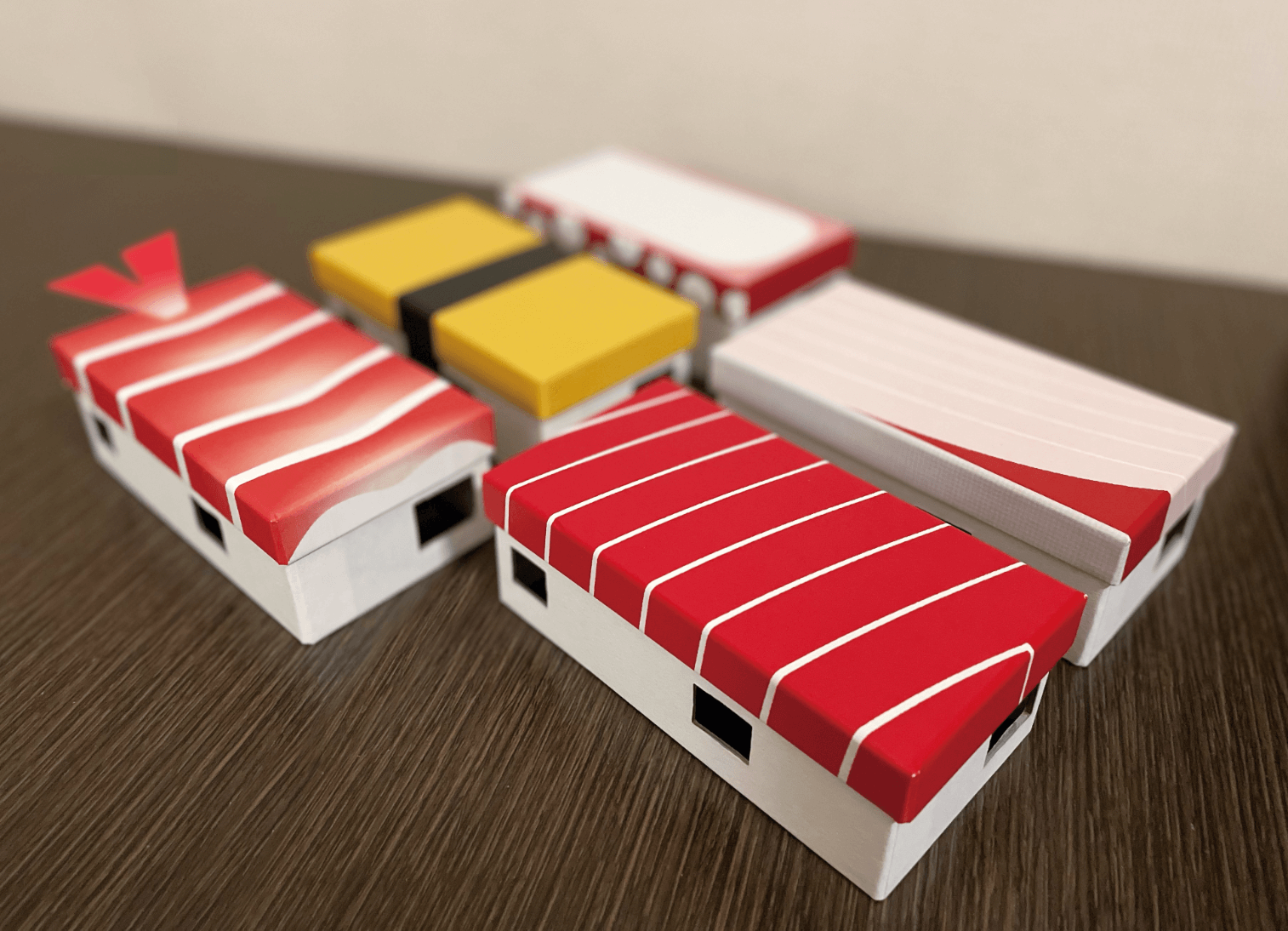
Check out these impressive projectors made exclusively for the sushi-netarium! These original sushi projectors in the shape of Saiki sushi are the only five such projectors in the world and come in the shapes of tuna, yellowtail, octopus, egg, and shrimp.
Come enjoy this strange sushi-centric activity in the south of Japan! Participating facilities are listed on the website below.
Information
Saiki City presents Sushi-netarium
Running: September 22 – November 30, 2022
Venue: Accommodations in Beppu City, Footbath Space at Oita Airport
Target Space: Accommodations listed below, Oita Airport Footbath Space
Details: https://www.visit-saiki.jp/topics/detail/eb9def81-fb90-40ae-9b5a-10c8d6c94b32
-
Attack on Titan in HITA Smartphone App Reveals Captain Levi 3D-AR Experience
19.July.2022 | ANIME&GAME / SPOT
Attack on Titan was created by Hajime Isayama, a manga artist born and raised in Hita, Oita Prefecture. Fans of the manga and anime series can experience the world of the famous series in his hometown, and by downloading a specific smartphone app and traveling to a specific location, they can now experience a new 3D-AR experience featuring Captain Levi. The installation will be installed at the camp resort Paradiso Oita in Oita Prefecture.
The AR application uses colored model data of the Captain Levi statue erected in the plaza in front of Hita Station on March 6, 2021. The realistic image of Captain Levi can be viewed from 360 degrees, and visitors can even take commemorative photos with the popular character!
The installation will be located at the Paradiso Oita Front Ridge, which costs nothing to enter. The grand opening will take place on July 22, 2022. With its convenient location just off the Amagase-Takatsuka interchange on the Oita Expressway, many believe that the installation will help to revive tourism in the area.
Information
Attack on Titan – Captain Levi 3D-AR
Release Date: July 14, 2022
Address: Paradiso Oita Front Ridge (9619-1 Tobata, Kusu, Kusu-ku, Oita)
Access: 3 minutes from Amagase-Takatsuka IC on the Oita Expressway
Attack on Titan in HITA Official Site: https://shingeki-hita.com
-
KYARY PAMYU PAMYU meets IMABARI: A Visit to the Historical Sea Route
Imabari is a city in Ehime Prefecture that faces the Seto Inland Sea. Since olden times, it has flourished as an important location for marine traffic. It’s home to a bounty of recognised national treasures and historical heritage sights, and is also famous for its production of citrus fruits such as mikan. Japanese pop star, model, and icon Kyary Pamyu Pamyu took a trip to this ancient city to discover its wonder and beauty.
A Visit to the Historical Sea Route
Oyamazumi Shrine
A ‘power spot’ revered by prominent people
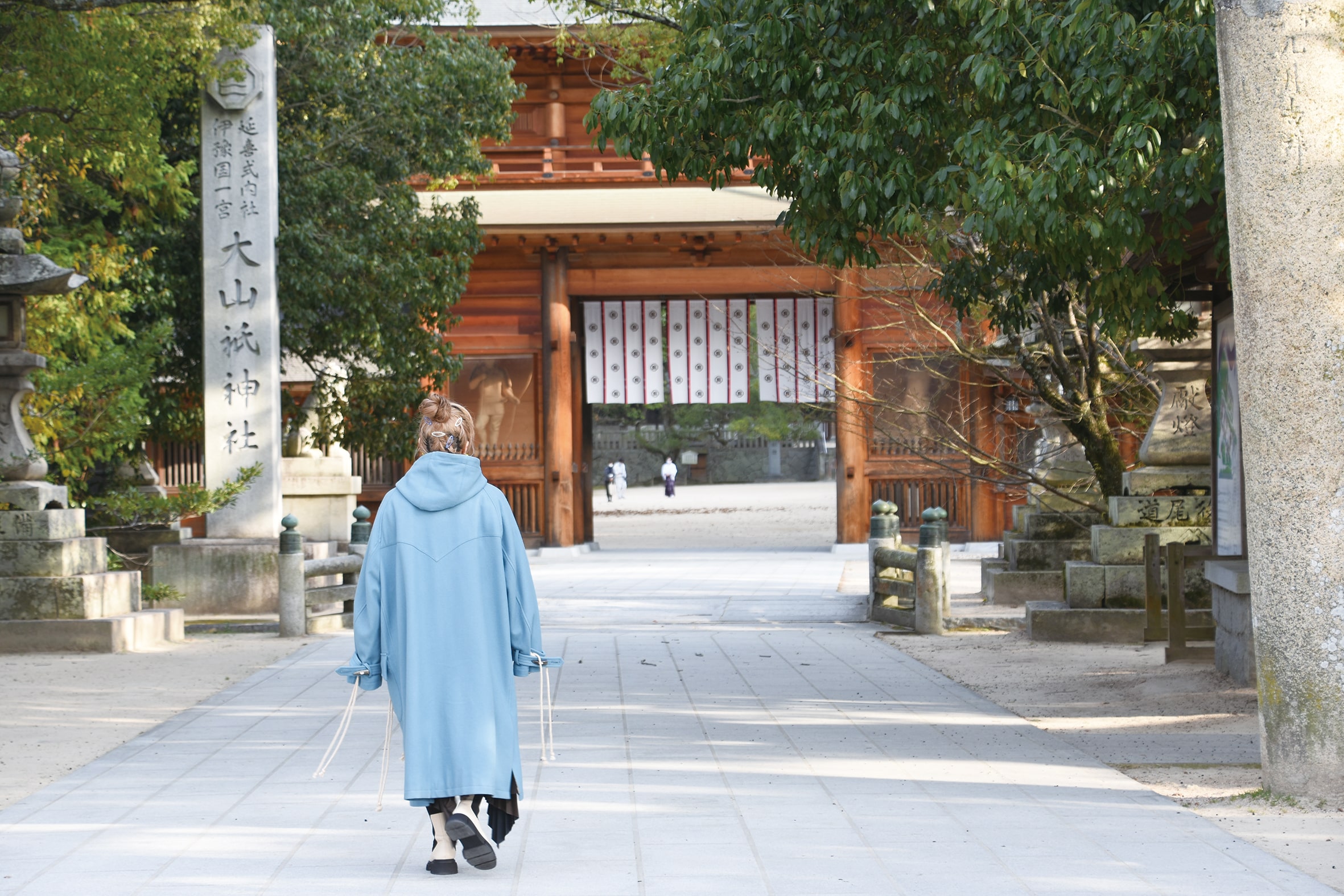
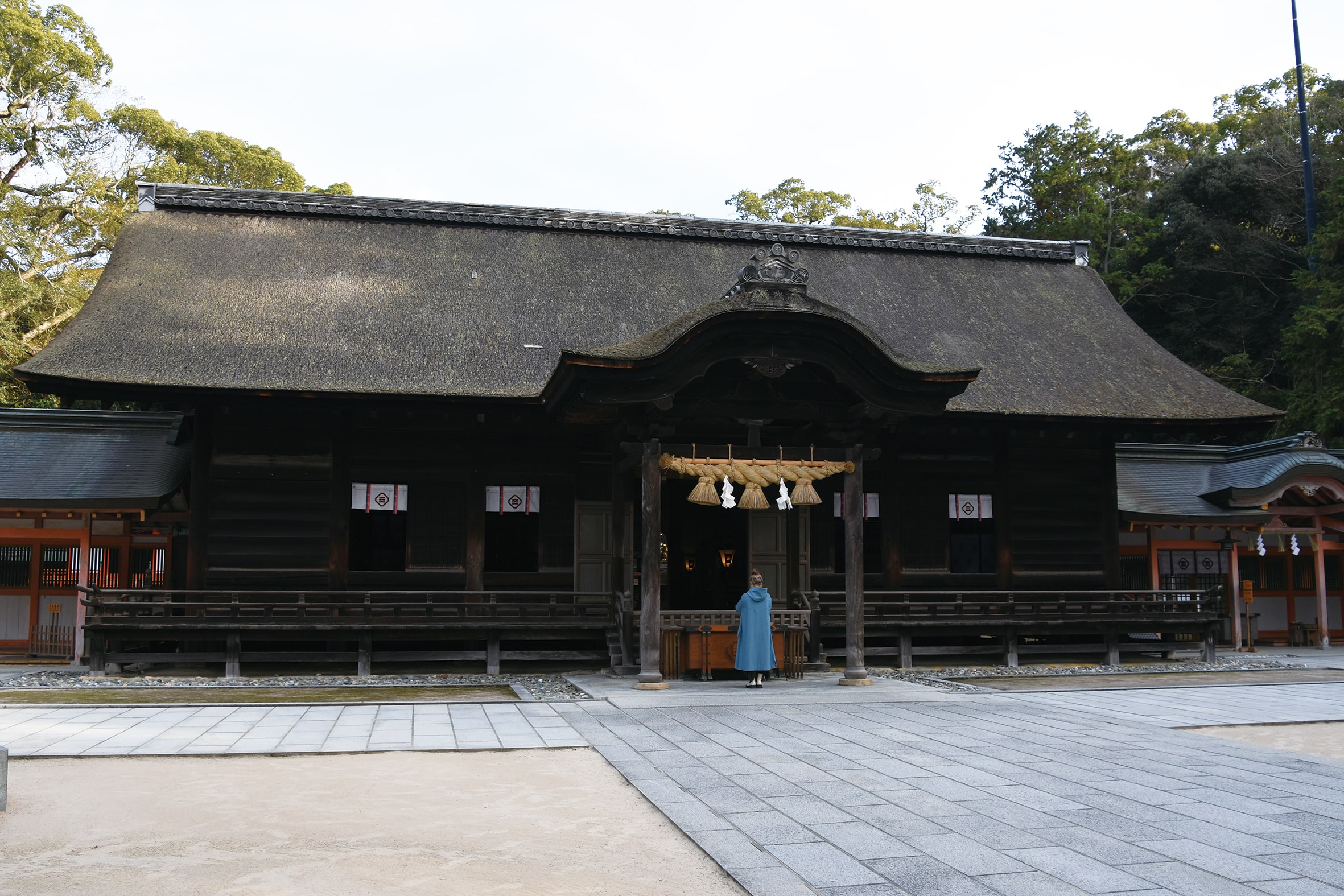
Oyamazumi Shrine has been revered by prominent figures throughout history as a place dedicated to the god of the mountain, god of the ocean, and the god of war. It’s home to numerous Important Cultural Properties which are available for viewing by the public such as the armour worn by the military commander Minamoto no Yoshitsune when the Minamoto clan won the Genpei War (1180-1185), armour worn by women, and more. The shrine is also a notable power spot for the ancient tree that has stood there for 2,600 years and is now recognised as a natural monument of Japan. Power spots are places in Japan where the spiritually-inclined draw energy from.
Information
Oyamazumi Shrine
Address: 3327 Omishimacho Miyaura, Imabari, Ehime 794-1393, Japan
TEL: 0897-82-0032
Opening Hours: Sunrise to 17:00
National Treasure Building: 8:30-17:00 (Last Entries 16:30)
Official Website: https://oomishimagu.jp/
Kurushima Kaikyo Service Area
Lip-smacking food aplenty
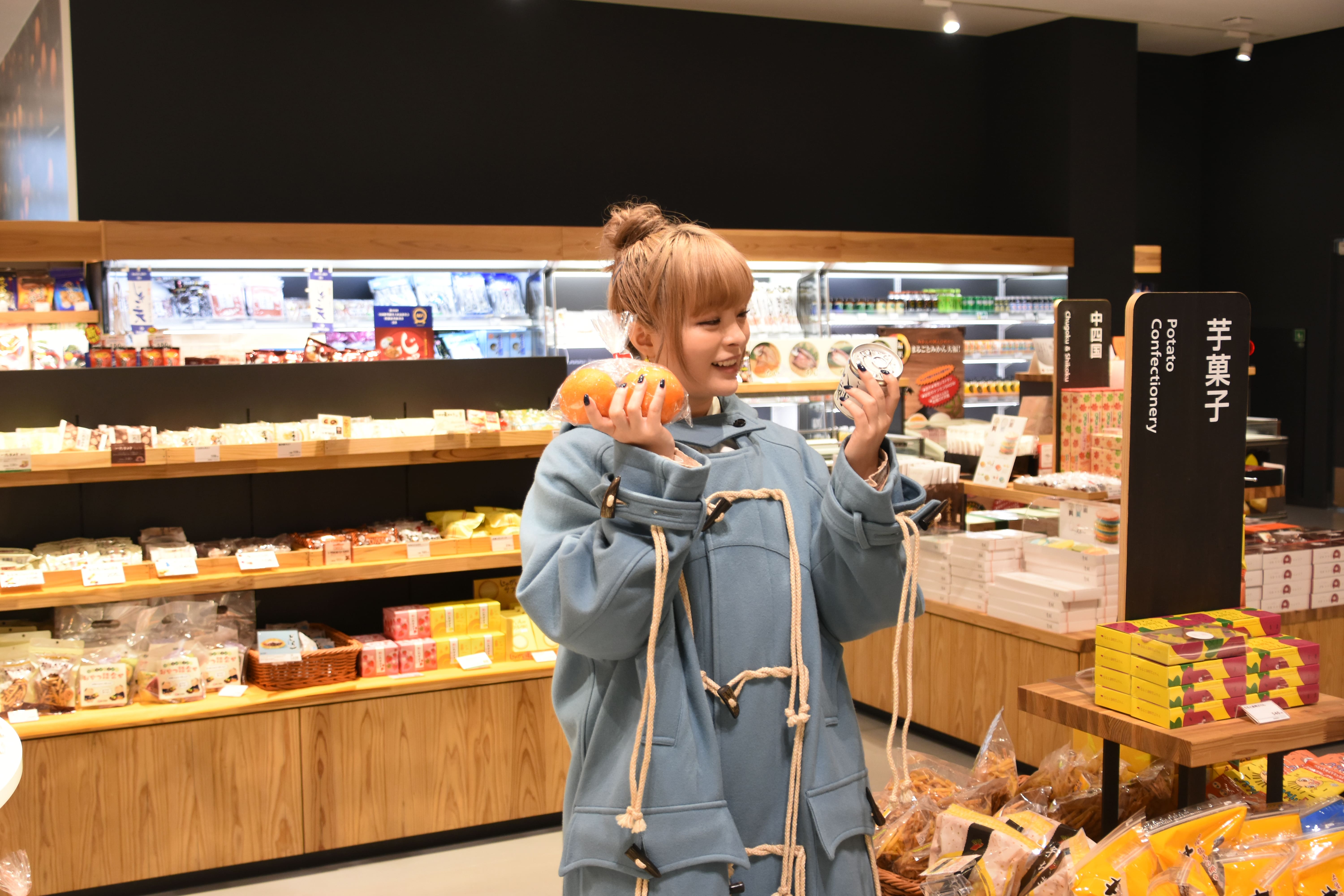
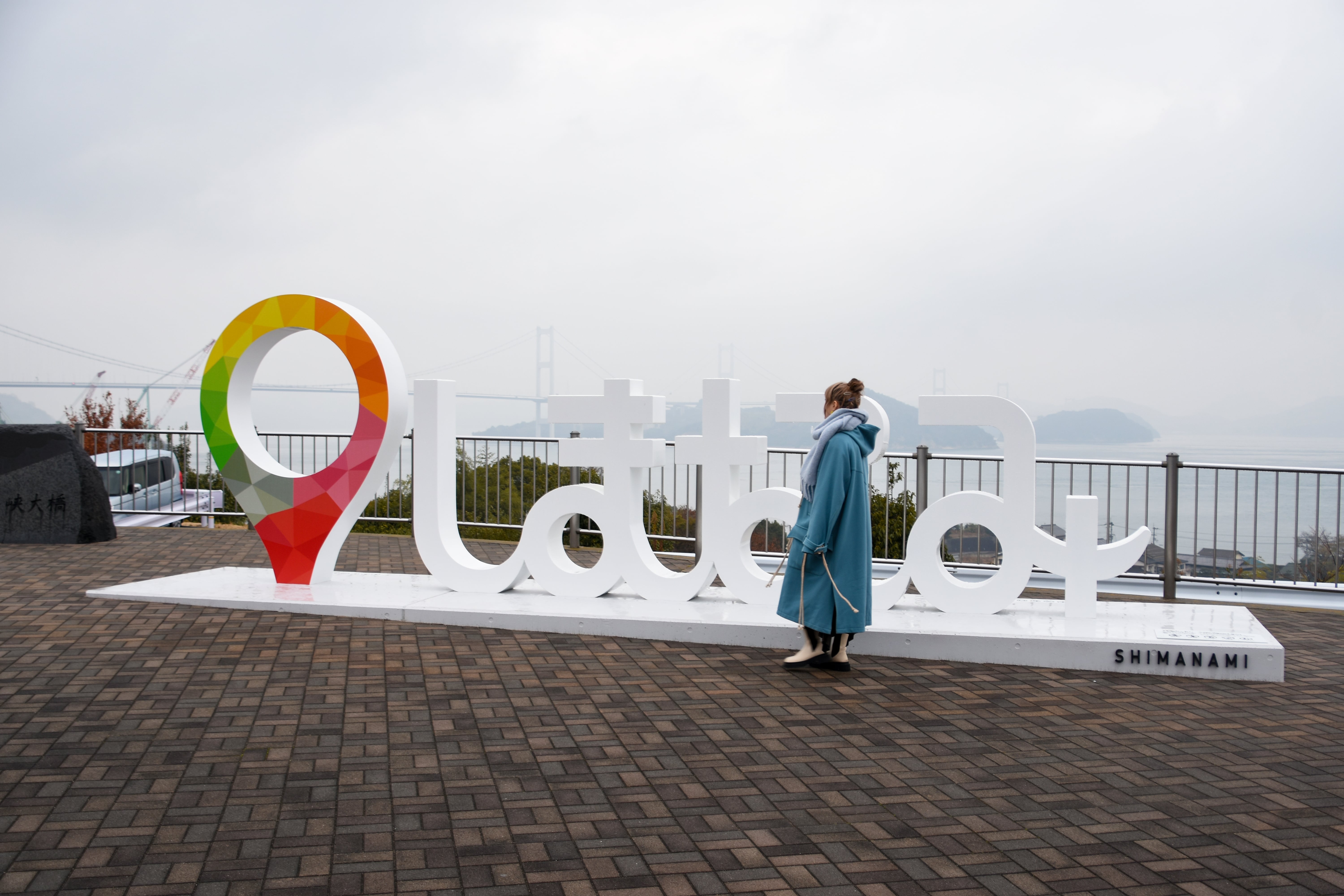
If you’re one for great views, then the Kurushima Kaikyo service area is a must-visit, offering a panoramic look at the Kurushima Strait of the Seto Inland Sea. The service area is very well know particularly for the Jaguchi Mikan Juice, something of a city legend in Ehime where you can enjoy fresh mikan juice straight from a tap. You can also tuck a rice bowl dish made with tachiuo hairtail caught in the Seto Inland Sea that’s made to look like Kurushima Kaikyō Bridge, or try Imabari’s soul food dish: the Imabari Yakibuta Tamago Meshi, a pork, egg, and rice bowl. Don’t pass up the chance to snap a photo at the designated photo spot with the Seto Inland Sea in the back either like Kyary above.
Information
Kurushima Kaikyo Service Area
Address: 3-9-68 Ohamacho, Imabari, Ehime, 794-0002, Japan
Food Court: [Weekdays] 8:00-21:00 / [Weekends & Holidays] 7:00-22:00
Shops: [Weekdays] 8:00-21:00 / [Weekends & Holidays] 7:00-22:00
Outside Shopping Area & Cafes: [Weekdays] 9:00-17:00 / [Weekends & Holidays] 9:00-18:00
Official Website: https://www.jb-highway.co.jp/sapa/kurushima.php
Murakami Suigun Museum
Dedicated to the Imabari heroes who protected the ocean
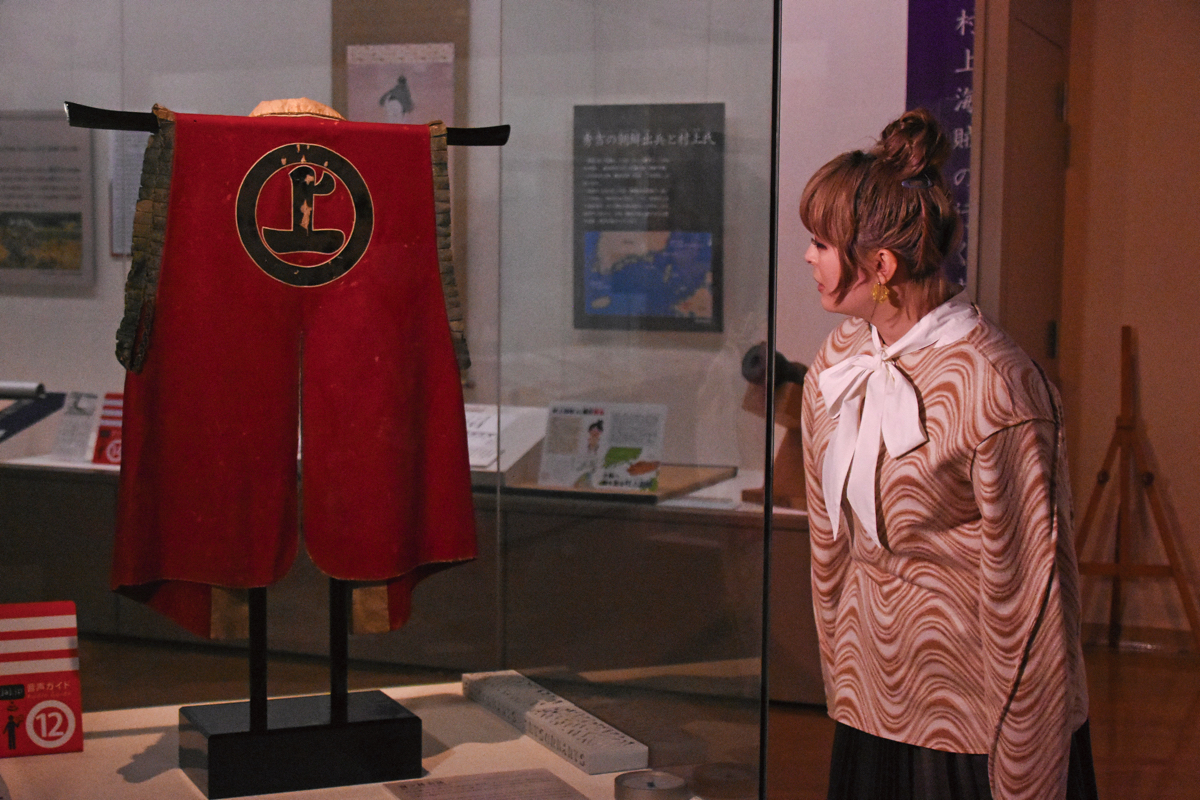
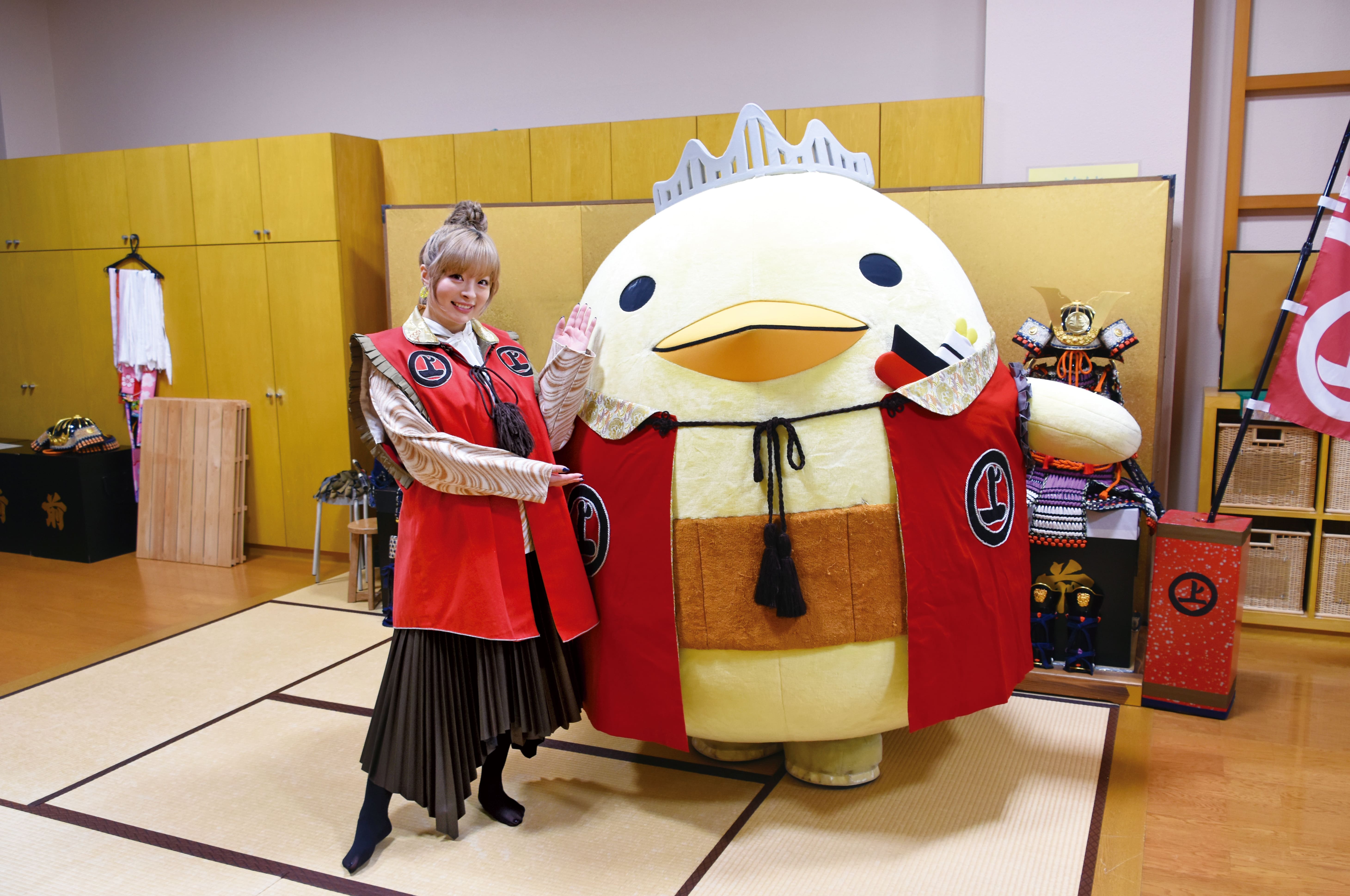
Murakami Suigun Museum is dedicated to kaizoku—pirates, or lords of the sea—something which conjures to mind villainy or bad guys, but the Murakami pirates were also considered heroes who helped maintain order and protect the sea during the Sengoku warring period of Japan. The museum features many displays of Murakami family treasures including the battle surcoat which the pirate leader wore over his armour, proudly bearing the Murakami family crest. Visitors can wear replicas of this coat, which Kyary tired herself: “Now I’m sorta like a military commander too,” she said.
Information
Murakami Suigun Museum
Address: 1285 Miyakubocho Miyakubo, Imabari, Ehime 794-2203, Japan
TEL: 0897-74-1065Opening Hours: 9:00-17:00
Closed: Mondays (or Tuesday if the Monday falls on a public holiday) / New Year Holidays (Dec 29-Jan 3)
Official Website: https://www.city.imabari.ehime.jp/museum/suigun/
Roadside Station Yoshiumi Iki-iki-kan
A bundle of fun and entertainment in one place
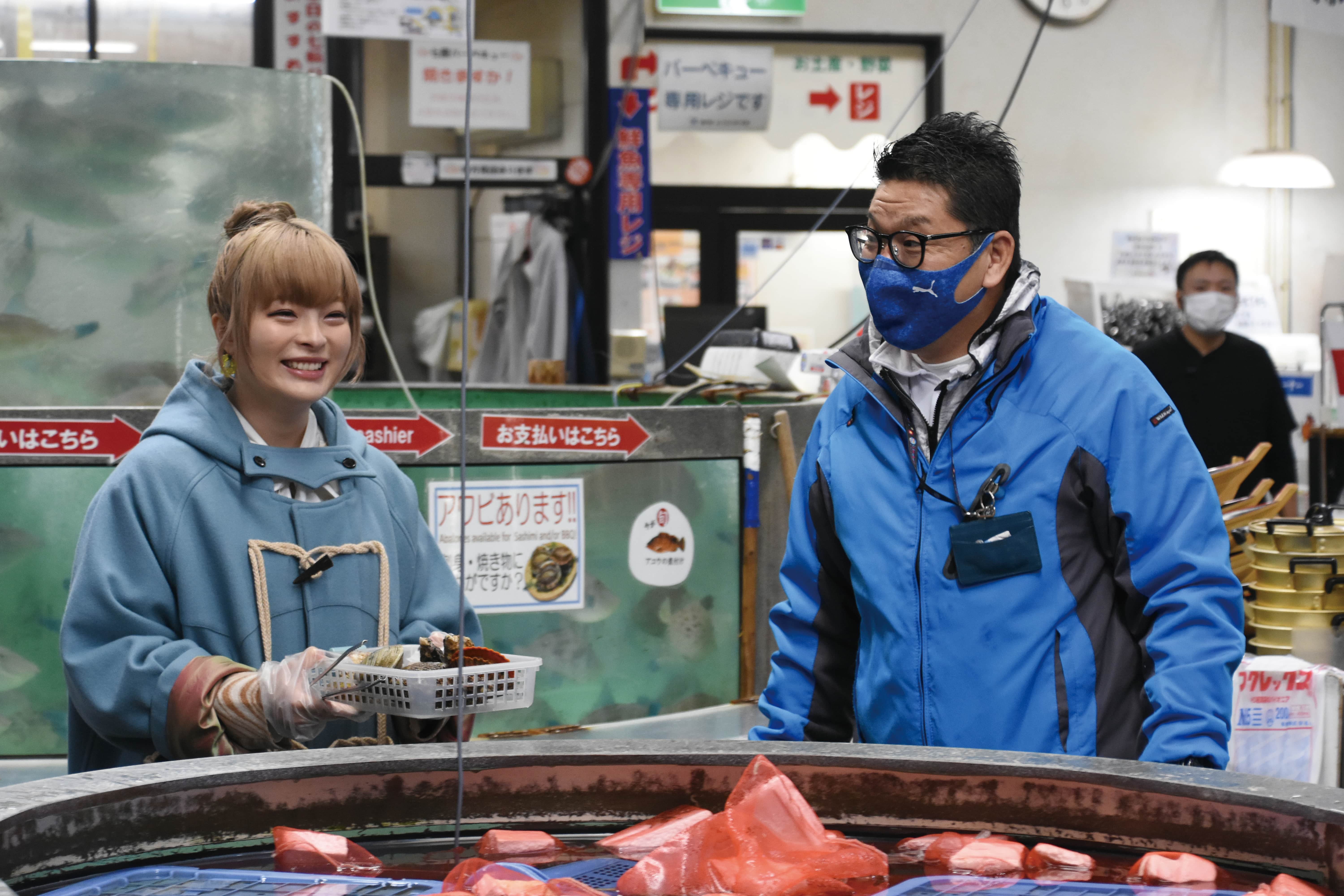
Roll on up to Roadside Station Yoshiumi Iki-iki-kan to enjoy a shichirin BBQ feast with fresh seafood caught in the Seto Inland Sea while gazing out across Kurushima Kaikyo. This building complex serves as a resting spot and is also the perfect place to purchase local souvenirs including Ehime specialty products. It’s also famous for its offering the chance to board a boat to ride around Kurushima Kaikyo, renting out bicycles, and more. You’ll also be able to meet Koro-chan, a popular fish who has lived there for 30 years.
Information
Roadside Station Yoshiumi Iki-iki-kan
Address: 4520-2 Yoshiumichomyo, Imabari, Ehime 794-2114, Japan
TEL: 0897-84-3710
Opening Hours: 9:00-17:00
Restaurant: 10:00-16:00 (Last Orders 15:00)
Closed: New Year’s Day (and certain days in winter)
Official Website: http://www.imabari-shimanami.jp/ikiiki/
Dolphin Farm Shimanami
Meet the cute and friendly dolphins
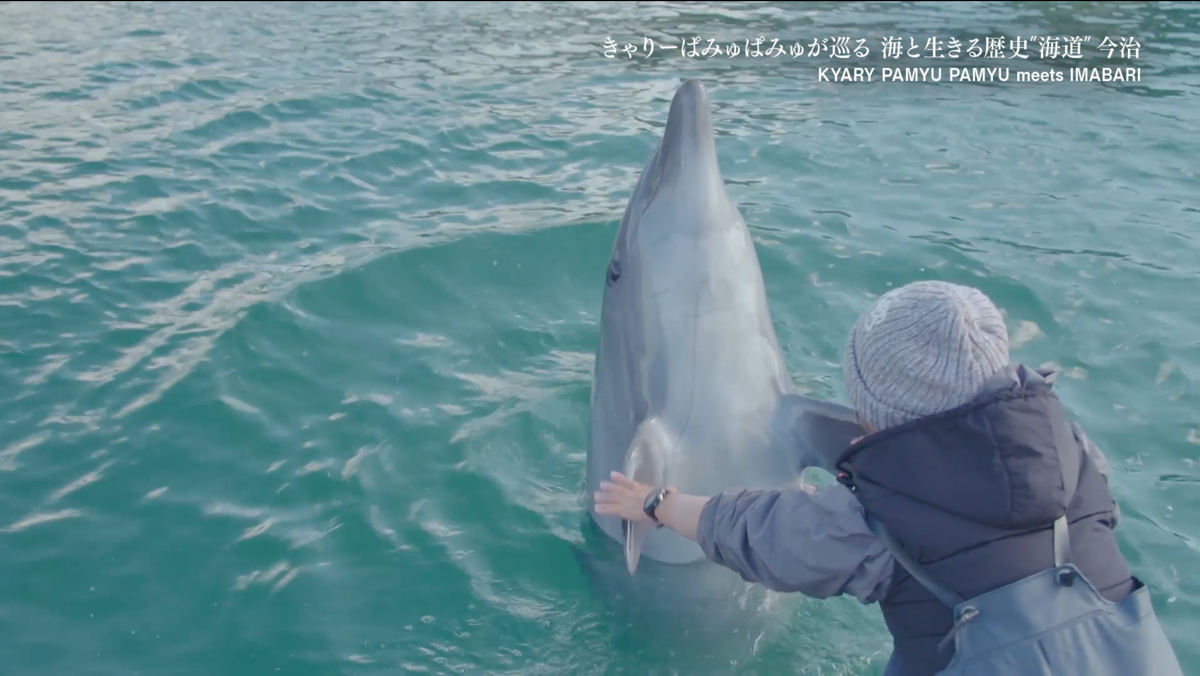
Dolphin Farm Shimanami, which is connected to Hakata Beach, is the best and biggest place in Japan to interact with dolphins. Visitors can get close to them and the dolphins will show off their tricks and skills. There’s even a car camping area you can stay at.
Information
Dolphin Farm Shimanami
Address: 1673 Hakatacho Kanoura, Imabari, Ehime 794-2302, Japan
TEL: 0897-72-8787
Opening Hours: 9:00-17:00
Closed: On days with bad weath
Official Website: https://www.df-shimanami.com/
Hakata Beach
A white sandy beach rolling out 200-meters
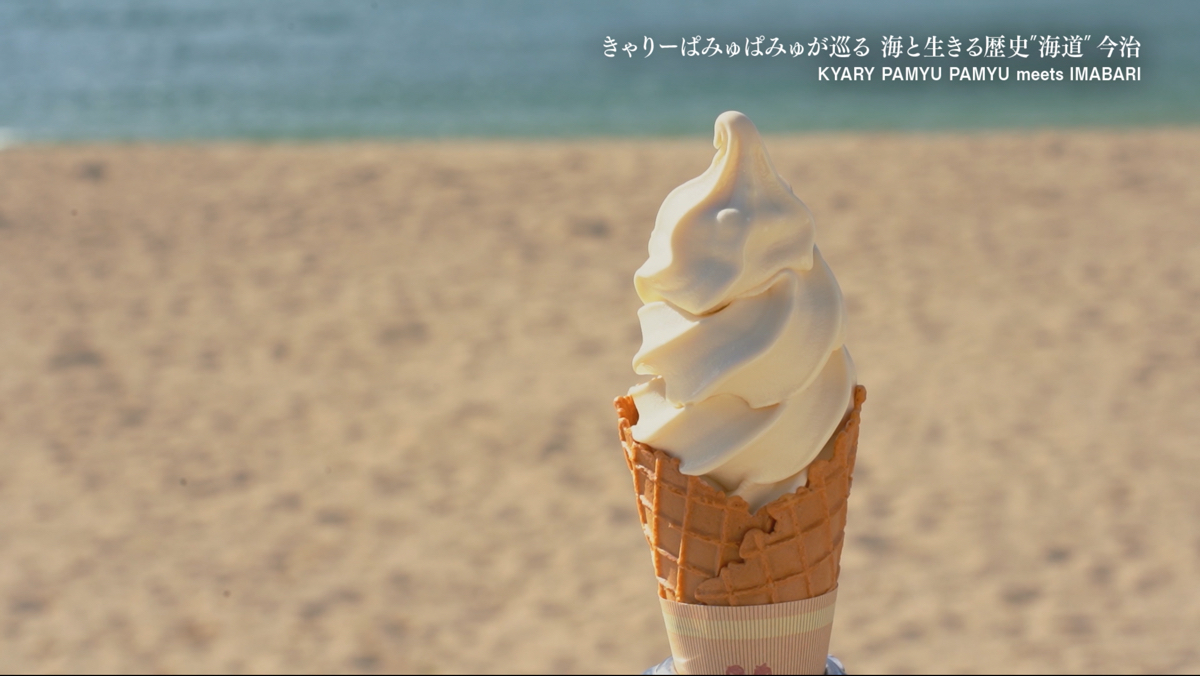
Hakata Beach is located at the base of Oshima Bridge in Hakata. The beach is famous for its salt which is best tried on their popular sweet-tasting sea salt ice cream.
Information
Hakata Beach
Address: 1668-1 Hakatacho Kanoura, Imabari, Ehime 794-2302, Japan
Sea Bathing: Early July – Late August
Official Website: https://www.city.imabari.ehime.jp/kanko/spot/?a=198
Imabari Towels
High quality towels woven with tradition and technique
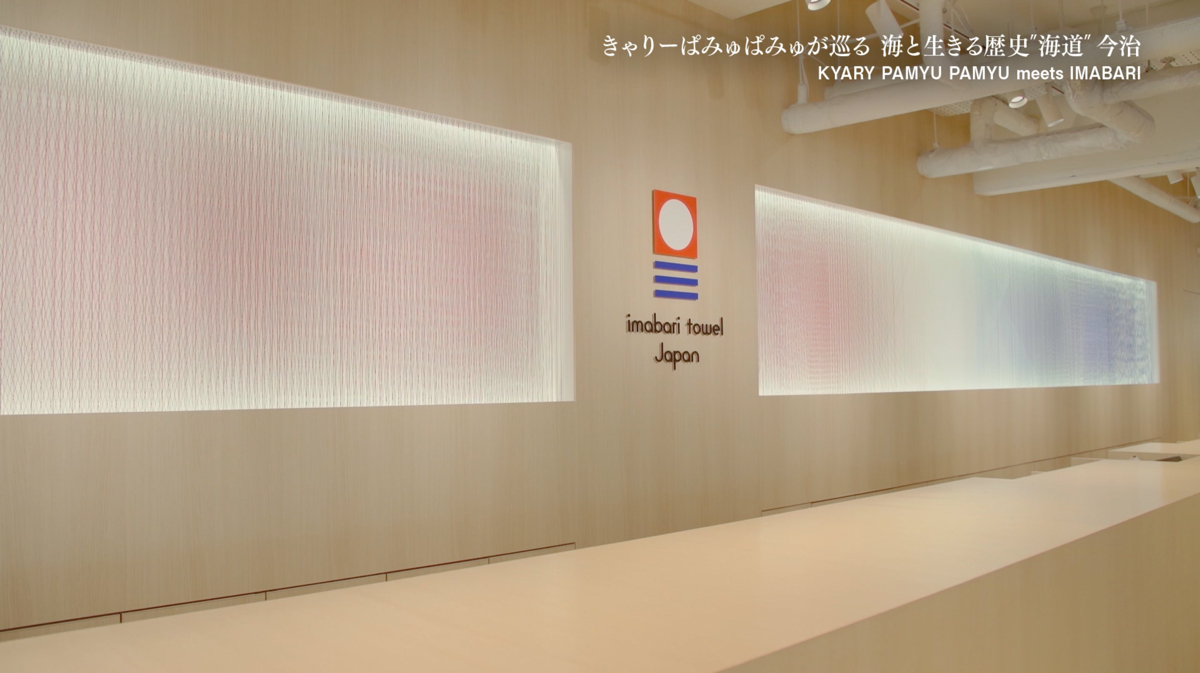
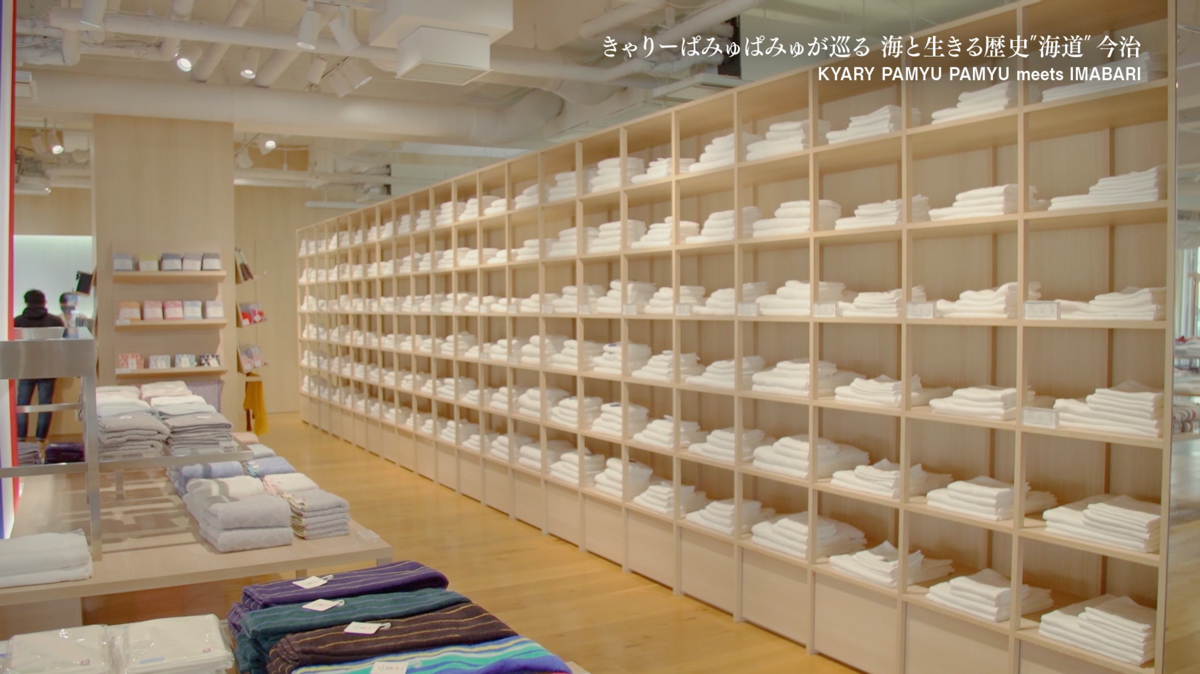
Imabari is the biggest producer of towels in Japan. Even their white towels alone have countless types you can choose from, allowing you to pick which level of softness and comfort you want. The iconic brand logo is also impactful, capturing the quality, production, and enthusiasm that the makes have for the product. Kyary herself uses them all the time!
Information
Imabari Towel
Official Website: https://www.imabaritowel.jp/
Sunrise Itoyama
Need a bike?
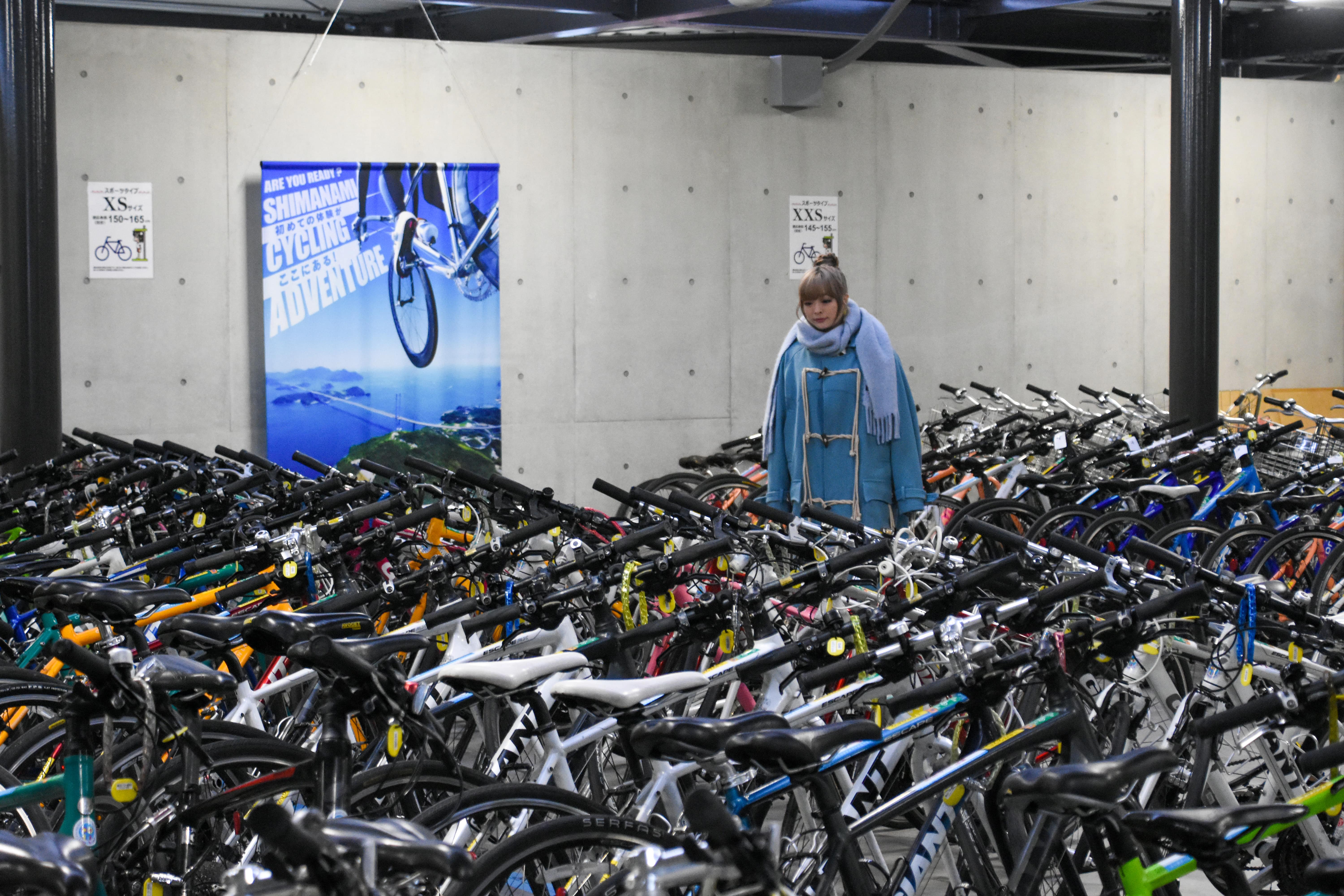
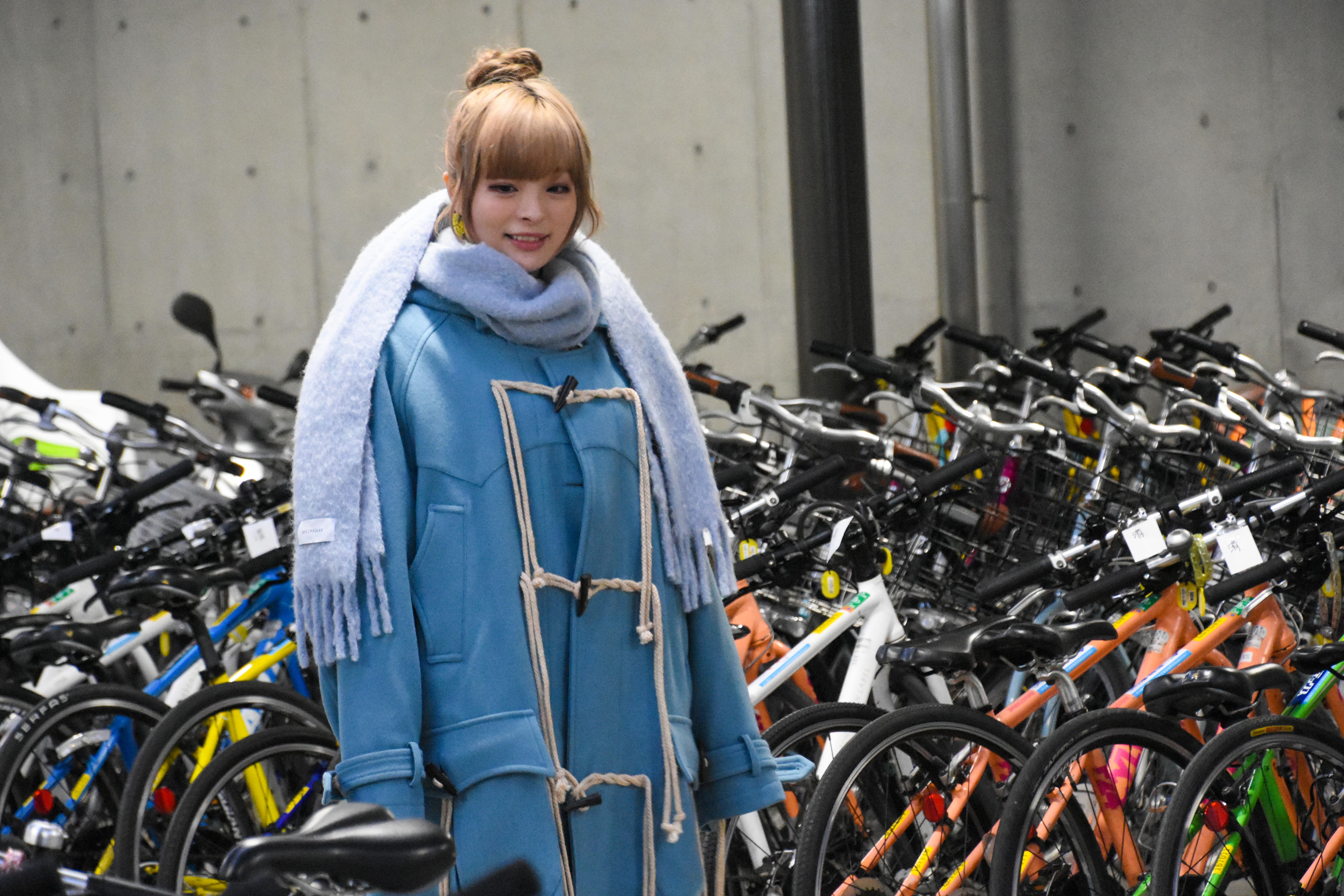
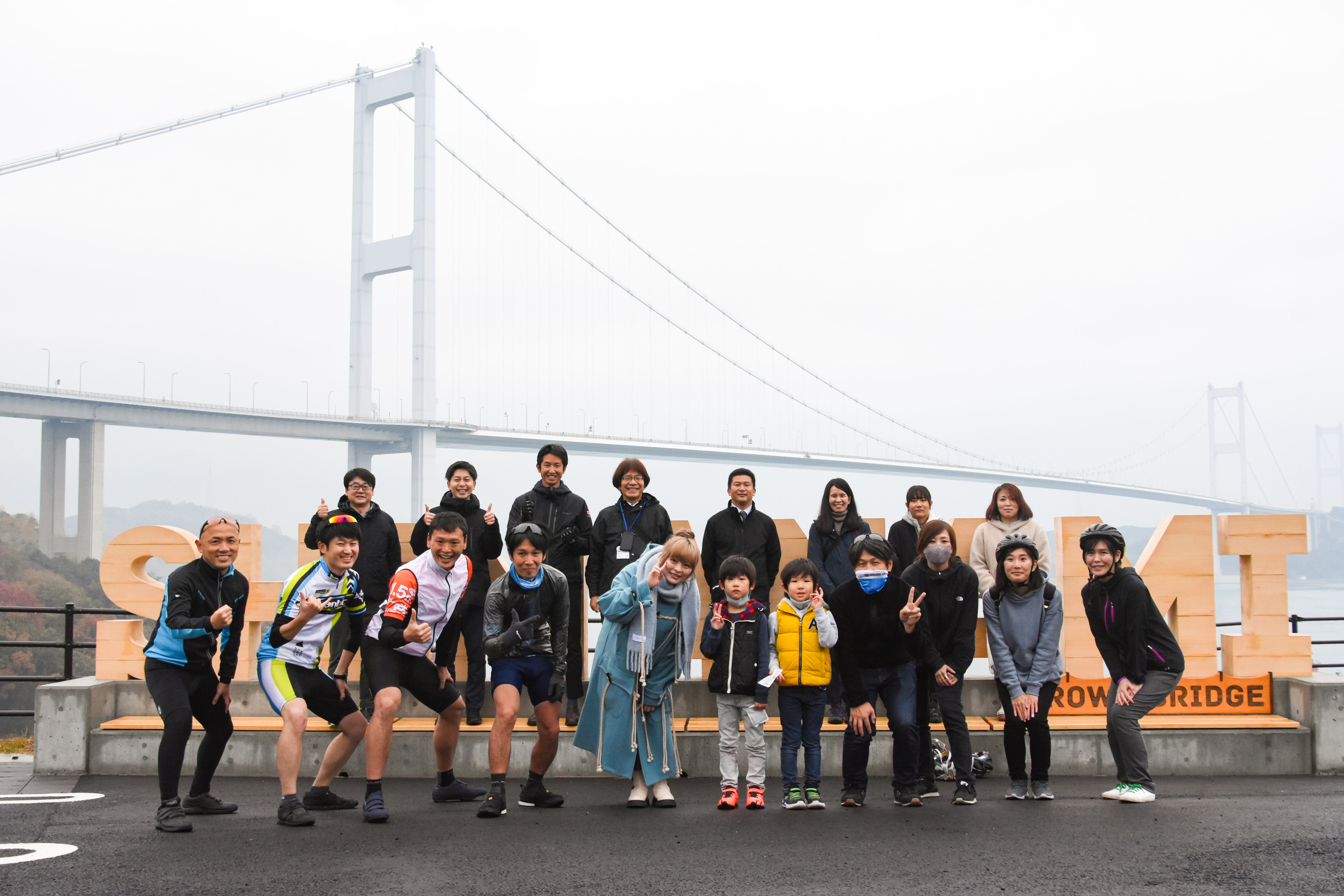
Sunrise Itoyama, located in the Imabari Central Cycling Terminal, is a rental bicycle service that has bikes and helmets for everyone’s needs. Rent out a bike and ride the Shimanami Sea Route which connects Ehime and Hiroshima with a series of bridges that hop across the islands of the Seto Inland Sea.
Information
Sunrise Itoyama
Address: 2-8-1 Sunabacho, Imabari, Ehime 794-0001, Japan
TEL: 0898-41-3196
Rent-a-Cycle Details: https://www.sunrise-itoyama.jp/archives/rentacycle/
Official Website: https://www.sunrise-itoyama.jp/
Marutomi
The famous restaurant known to every local
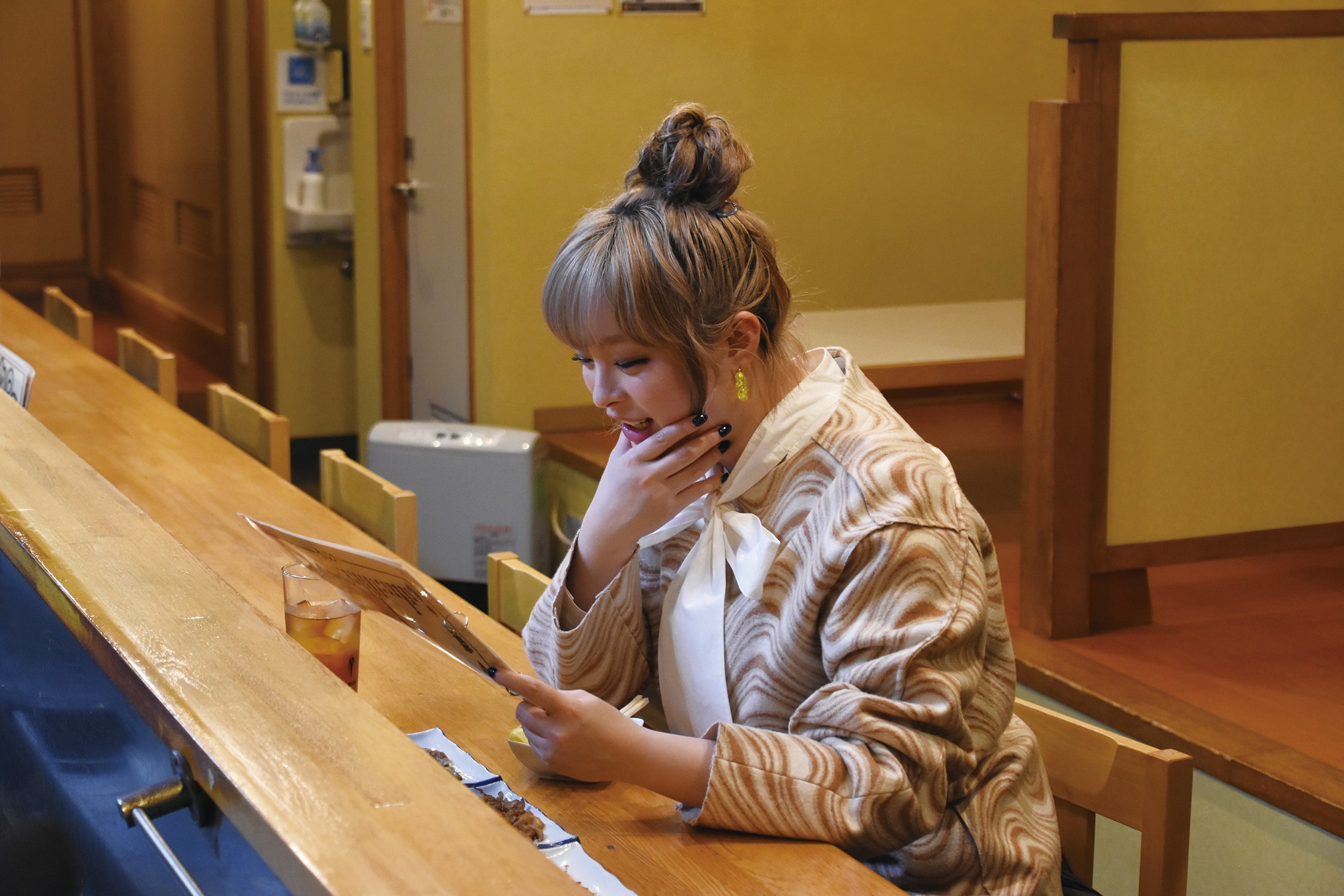
If you want the real experience of Imabari’s yakitori soul food, you should visit Marutomi, a yakitori eatery. Imabari yakitori is different from the usual Japanese yakitori as it doesn’t come skewered. Instead, the chicken is cut into small pieces and fried that way. One of the most popular ways to have it is with the skin on so the outside is crunchy and the inside succulent. It goes perfect with a cup of sake too.
Information
Marutomi
2-3-6 Katayama, Imabari, Ehime 794-0063, Japan
TEL: 0898-23-2740
Opening Hours: 17:30-22:00
Closed: Wednesdays
Official Website: https://maru-marutomi.jp/
Imabari Castle
A castle by the sea
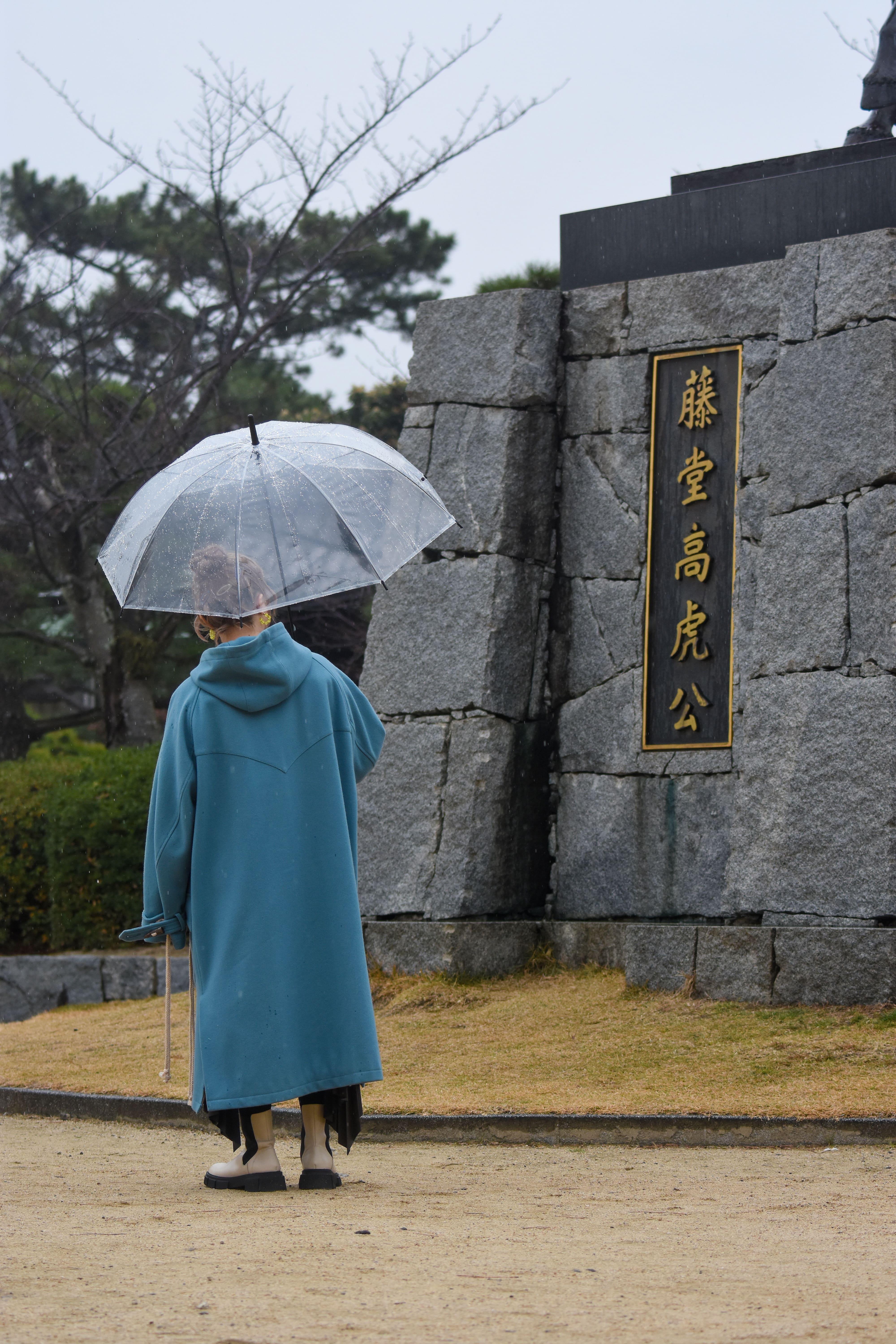
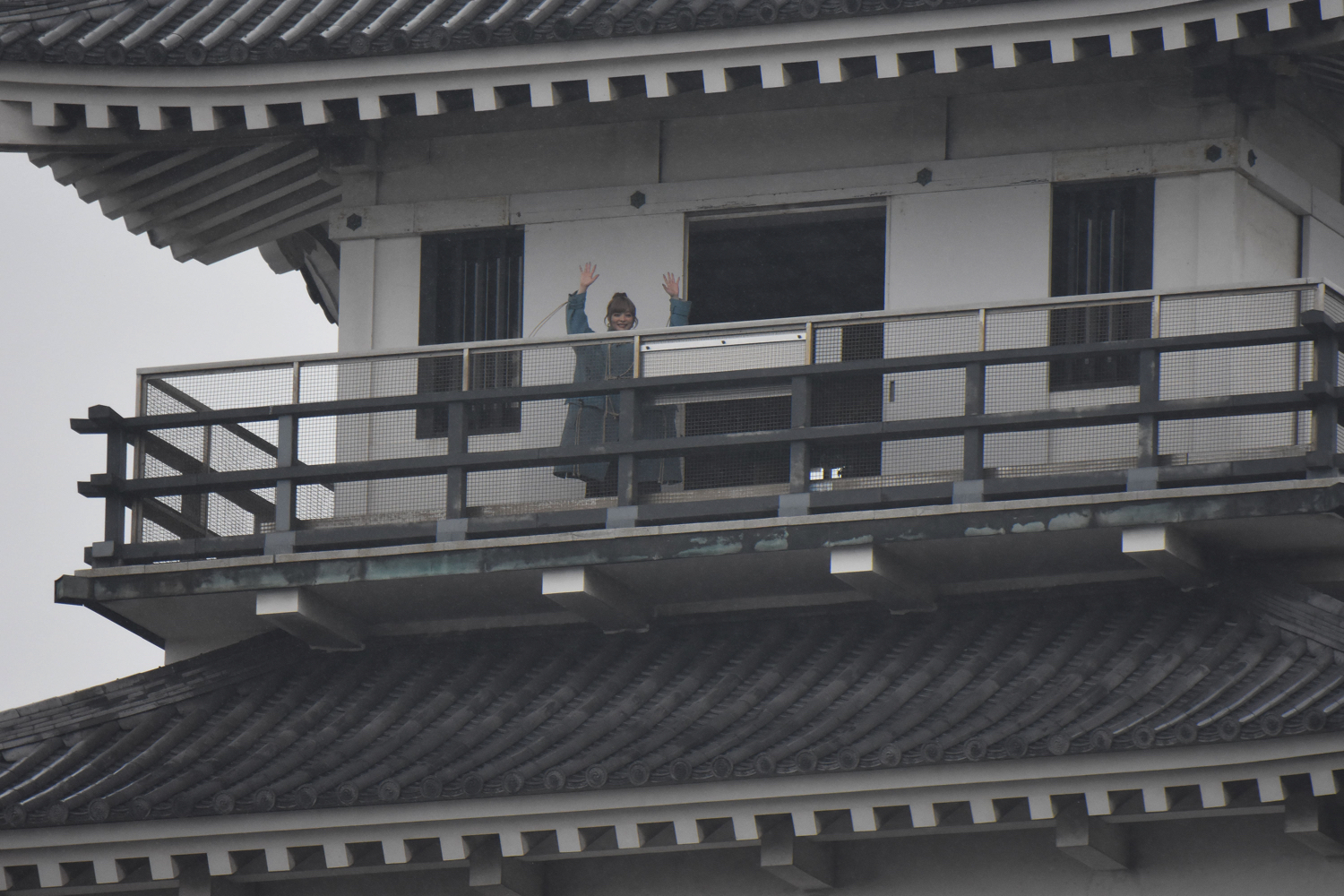
Imabari Castle, built by the daimyo Tōdō Takatora, is known famously as one of Japan’s three “Castles on the Sea” and was also listed in Japan’s Top 100 Castles. When it was first constructed, boats could enter the moat from the ocean. It’s a site that breathes the prosperity that Imabari has enjoyed as a significant location for maritime traffic, the same Imabari that the Murakami pirates sought to protect. Head on up to the top of the castle to stand on the observation deck and gaze at an unbroken view of the city.
Information
Imabari Castle
Address: 3-1-3 Toricho, Imabari, Ehime, 794-0036, Japan
TEL: 0898-31-9233
Opening Hours: 9:00-17:00
Closed: December 29 – December 31
Official Website: https://www.city.imabari.ehime.jp/museum/imabarijo/
Kirosan Observatory Park
A breathtaking spectacle to remember
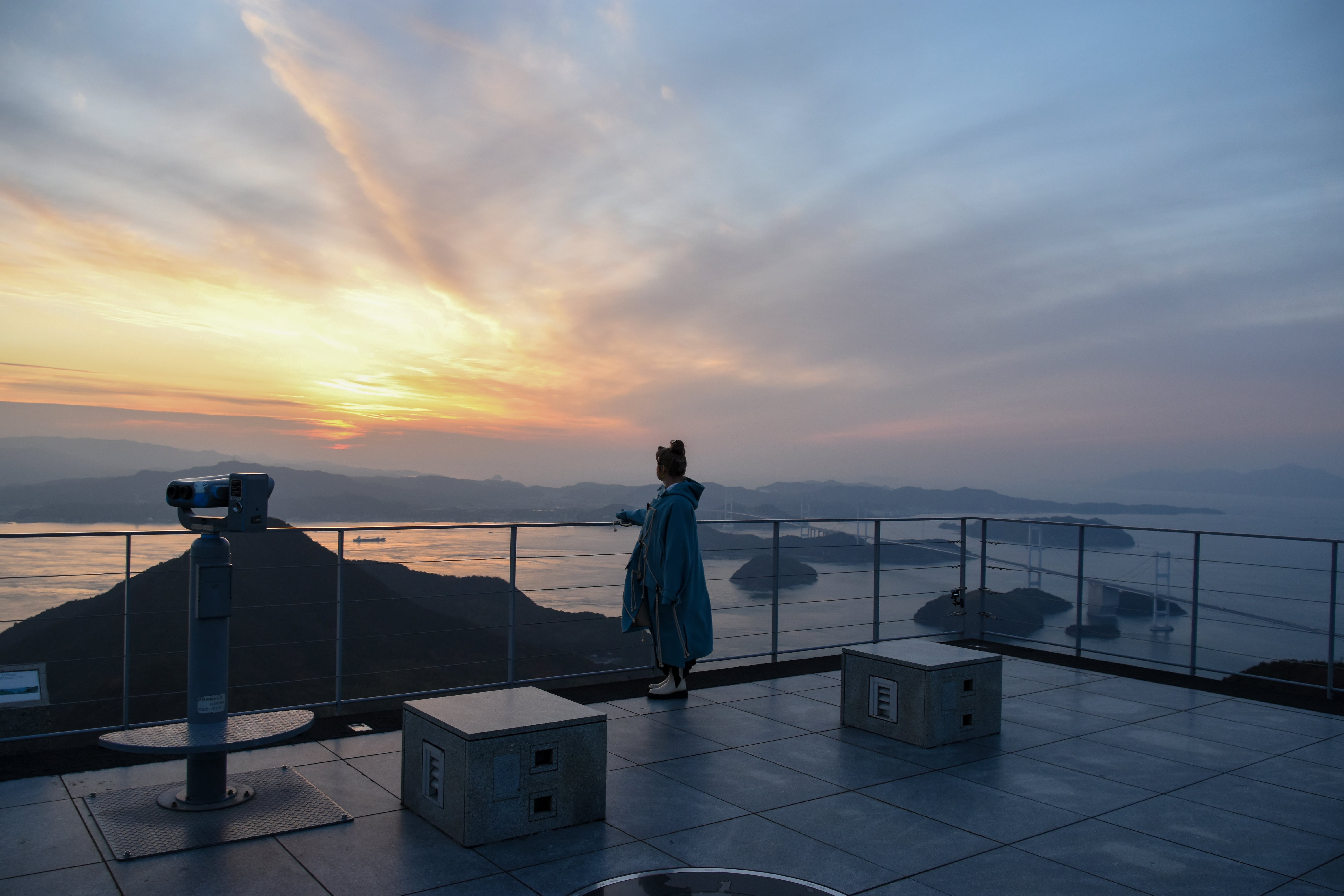
Kirosan Observatory Park is officially recognised by Setonaikai National Park. Standing atop the observation deck fills the eyes with wonder as they gaze upon a panoramic stretch of Imabari, the Seto Inland Sea, and Kurushima Kaikyo all at once. Kyary wrapped up her time in Imabari here as the sunset coloured the sky and sea in warm evening hues.
Information
Kirosan Observatory Park
Address: 487-4 Yoshiumicho Minamiura, Imabari, Ehime 794-2115, Japan
No Fixed Holidays
Open 24-hours a day
Official Website: https://www.city.imabari.ehime.jp/kanko/spot/?a=182
Imabari Tourism Information: https://www.city.imabari.ehime.jp/kanko/
We hope you enjoyed joining Kyary on her adventures across Imabari, and perhaps she even got you a little curious in wanting to visit the city yourself. It’s a treasure trove filled with vistas by the sea, in nature, and in the city itself with its Important Cultural Properties. Food is also a big part of travel for many people, so you can rest assured that your belly will be satisfied in Imabari as you try their speciality mikan, fresh seafood fished in the Seto Inland Sea, and more.
Information
Kyary Pamyu Pamyu
Official Instagram: https://www.instagram.com/kyarypappa (@kyarypappa)
Official Twitter: https://twitter.com/pamyurin (@pamyurin)
Official Website: http://kyary.asobisystem.com/
-
All About Matsuyama | Final Episode: Introducing the New Matsuyama Tourist Information Centre
The reception staff are ready and waiting to greet customers with a smile
The all new Matsuyama Tourist Information Centre finally opened in the heart of Matsuyama—the capital city of Ehime Prefecture in Japan—in Okaido on May 27. You’ll find it on the first floor of Matsuyama Mitsukoshi which isn’t even a one-minute walk from Okaido Station. It features an interior fusion combining history and culture with a design inspired by Matsuyama Castle while also throwing in a contemporary feel.
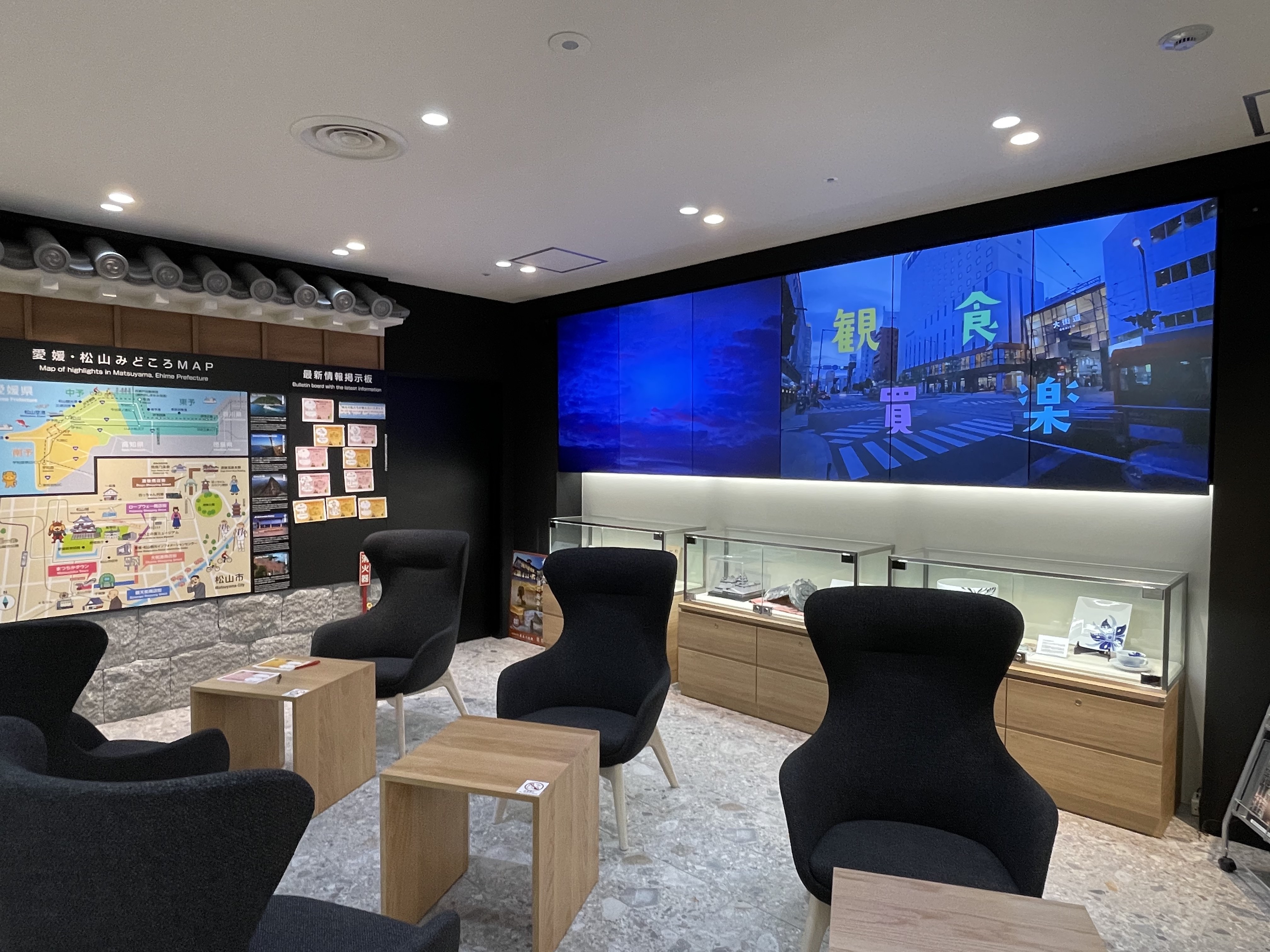
Six giant screens serve as the perfect place for tourism-related PR of Matsuyama
The first sight many visitors will lay their eyes on upon entering the information centres are the six screens spanning 1.5 meters high and 4.5 meters across the wall. Here, a variety of promotional material centred on the highlights of Matsuyama will be displayed.
The information centre offers many useful services, including for foreign customers who don’t speak Japanese. There is a translation and interpreting service, money exchange, rental electrical outlets for smart devices, and more. The staff themselves are multilingual, but the interpreting service includes access to a call centre which you can access using the free WiFi or using an iPad. The availability of foreign currency exchange is also extremely beneficial as Matsuyama is a city abundant with long-standing shops that have been around for decades and longer. Another convenience with the centre is easy access to public transport. If you’re looking to travel around the prefecture, we recommend paying a visit to the centre first as it’s sure to provide valuable information. You can even rent mobile batteries for your smartphone to lessen the stress when sightseeing.
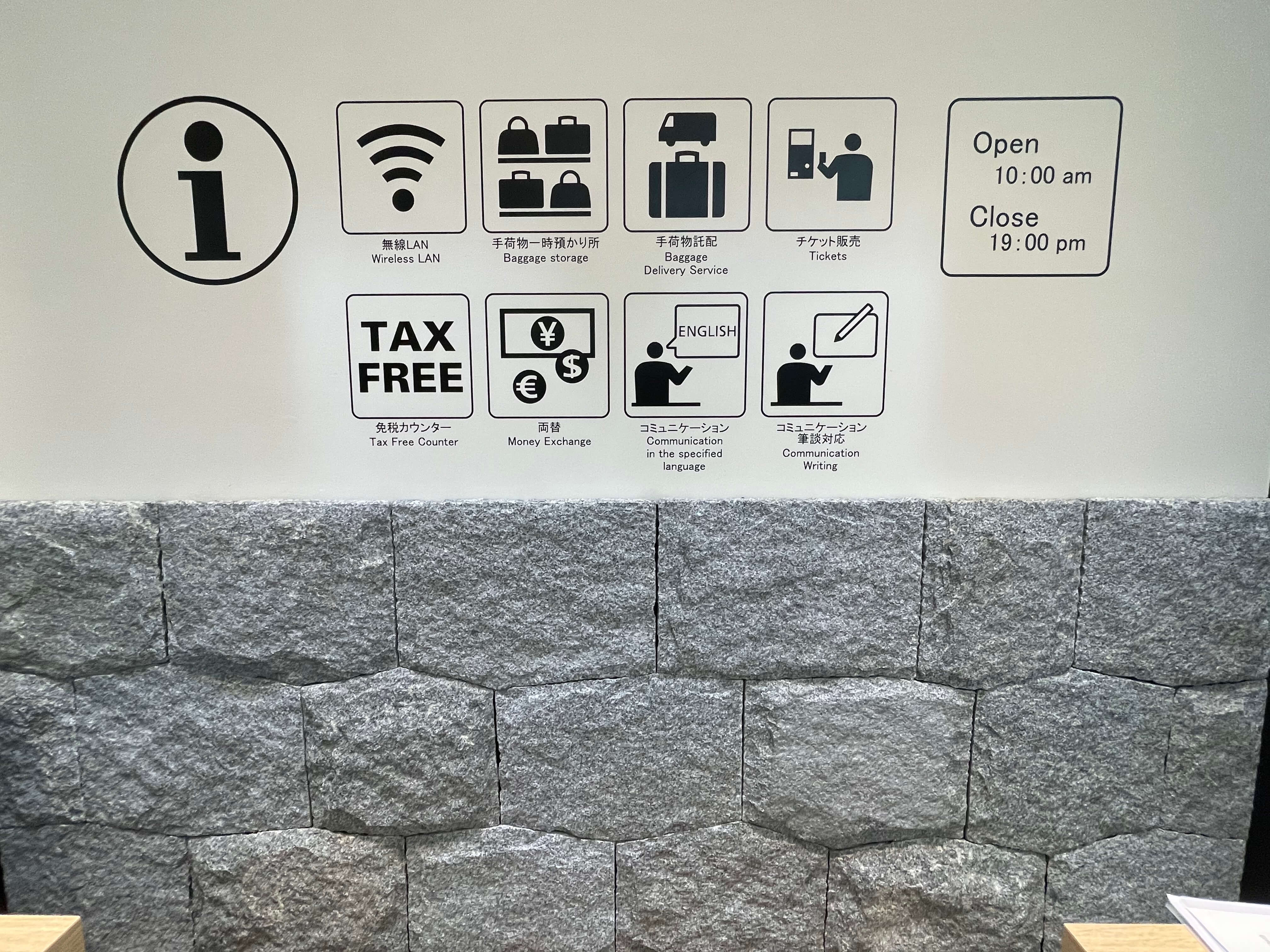
The pictogram shows the many handy services available
Visitors will also find a comprehensive duty-free counter inside the information centre which covers all stores in Okaido, Gintengai, Matsuchika Town, Dogo Shoten, and Ropeway Shotengai. You must spend over ¥5,000 (before tax) on products to be duty-free eligible. Since it’s a comprehensive service, if you have multiple receipts you can be exempt from tax as long as all your receipts exceed ¥5,000. Participating stores have special stickers plastered up inside so tourists can quickly and easily identify them.
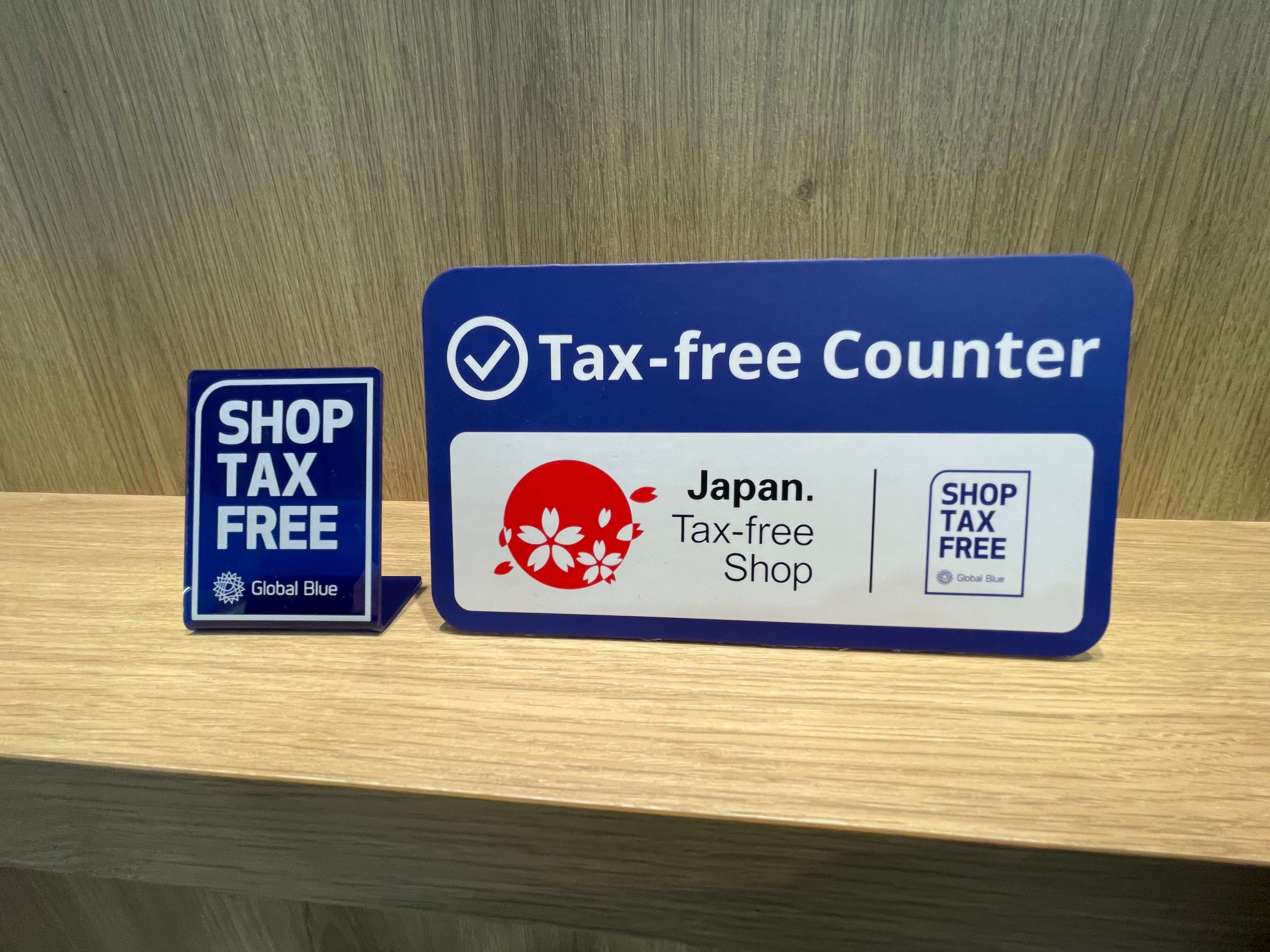
Stores participating in the duty-free service have stickers and signs to show it
For example, if you spend ¥500 at participating stores in Dogo Shotengai, ¥1,000 in Okaido Shopping Street, and ¥3,500 in Gintengai Shotengai, and take all three of those receipts adding up to ¥5,000 to the information centre, you can get your items duty free. But keep in mind that the receipts have a validity period on them, so be sure to check opening hours.
The Matsuyama Tourist Information Centre serves as the perfect site for bringing in all kinds of tourists, including foreign travellers, to Matsuyama post-COVID. The information also goes by the cute nickname “Dan Dan info.” Dan dan is an old Ehime phrase meaning “thank you” and ties in with the smiling and hospitable welcome staff wish to greet guests with. It’s exciting to look into the future and see how Matsuyama’s tourism and economic growth will develop in its shopping districts, stores, and elsewhere. Make one of your first stops the Matsuyama Tourist Information Centre when visiting the city.
Information
Matsuyama Tourist Information Centre
Opened: May 27, 2021
Address: Matsuyama Mitsukoshi Floor 1F Atrium Space Court, 3-1-1 Ichibancho, Matsuyama, Ehime
Homepage: https://matsuyama-tourism.com/
Facebook: dandaninfo
Instagram: dandaninfo_matsuyama
-
All About Matsuyama | Episode 8: Souvenirs Are Part of Matsuyama’s Fun and Are Everywhere
The all new Matsuyama Tourist Information Centre opened in the heart of Matsuyama—the capital city of Ehime Prefecture in Japan—in Okaido on May 27. In celebration of its opening, this new featured series by MOSHI MOSHI NIPPON will explore the wonders of Matsuyama, a city abundant with places to shop, leisurely hot spots, must-visit restaurants, and opportunities to dive deep into its history and culture. You’re sure to discover something new and exciting about Matsuyama in this series.
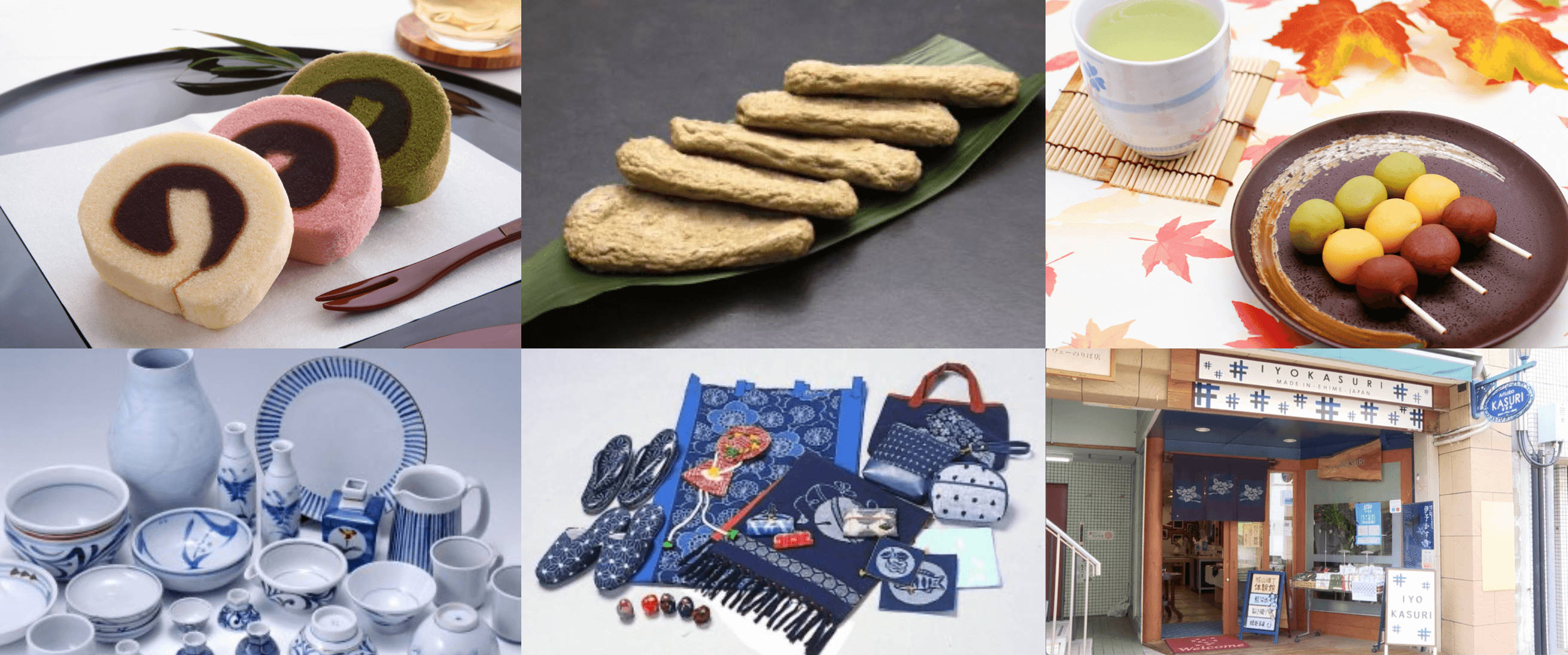
From tasty treats to home and lifestyle goods, Matsuyama has no shortage of souvenirs
Popular sightseeing spots and delicious food you can’t get anywhere else—these are all part of the fun experience to be had when travelling. To wrap up your time there and memorialise all that’s happened, nothing’s better than picking up a little souvenir. In Episode 8 of All About Matsuyama, we take a look at the many wonderful items you can take home with you as souvenirs from food to traditional handicrafts, special dyed fashion and accessories, and more. MOSHI MOSHI NIPPON has picked out a range of delightful treats like Matsuyama’s famous tartes, jakoten, three-colour botchan dango as well as Tobe ware porcelain which is an Ehime tradition, and iyo-kasuri fabric which is one of Japan’s three main kasuri fabrics.
First on the list is the ‘tarte,’ a speciality product of Shikoku which is more of a sponge cake. They’re made of a soft and fluffy sesame seed-coloured sponge and coarse red bean paste. A famous treat of Matsuyama, you can find these tarts just about anywhere in Okaido Shopping Street, near Dogo Onsen, and elsewhere.
Jakoten is considered a soul food of Ehime Prefecture. It’s made from fish that are blended into a paste and fried. You can find jakoten everywhere in Matsuyama, but every restaurant serves theirs with different textures and flavours. Many places fry them fresh, so be sure to try a bunch to compare the flavours and then you can decide which to buy as a souvenir. There are even places so popular that they have lines outside them before they even open.
The botchan dango is something many of our readers have probably seen or heard about. These three-coloured skewered dango are served bite-sized, cute enough to snap a photo of. The ones sold at Dogo Onsen are something of a speciality. They have their name from Natsume Soseki’s novel Botchan. You’ll find them all around Dogo Shotengai.
Tobe ware is a traditional type of porcelain from Tobe in Ehime, known for its smooth touch and durability. This traditional porcelain has been handed down from old times until today, and in recent years, ceramists have been hammering out their own unique shapes, so have become popular as stylish, everyday use lifestyle items.
You can’t talk about Ehime’s traditional craftwork without mentioning iyo-kasuri fabric. Matsuyama used to have huge production output of this fabric type, which stands as one of three of Japan’s most famous kasuri fabrics alongside kurume-gasuri from Fukuoka and bingo-kasuri from Hiroshima. Production has dwindled in modern times, but if you go to Art Labo KASURI Rekishikan, you can learn all about iyo-kasuri. There are lots of gorgeous iyo-kasuri products to buy like cute pouches, bags, and more.
And that’s our list of must-grab souvenirs. There are of course endless other things you can get your hands on, so if you’re lost on what to pick up, try asking at the Matsuyama Tourist Information Centre.
Stay tuned for the next and final episode of All About Matsuyama.
Information
Matsuyama Tourist Information Centre
Opened: May 27, 2021
Address: Matsuyama Mitsukoshi Floor 1F Atrium Space Court, 3-1-1 Ichibancho, Matsuyama, Ehime
Homepage: https://matsuyama-tourism.com/
Facebook: dandaninfo
Instagram: dandaninfo_matsuyama
-
All About Matsuyama | Episode 7: Mitsuhama Port is a Nostalgic Trip Down Memory Lane
The all new Matsuyama Tourist Information Centre is set to open in the heart of Matsuyama—the capital city of Ehime Prefecture in Japan—in Okaido on May 27. In celebration of its opening, this new featured series by MOSHI MOSHI NIPPON will explore the wonders of Matsuyama, a city abundant with places to shop, leisurely hot spots, must-visit restaurants, and opportunities to dive deep into its history and culture. You’re sure to discover something new and exciting about Matsuyama in this series.
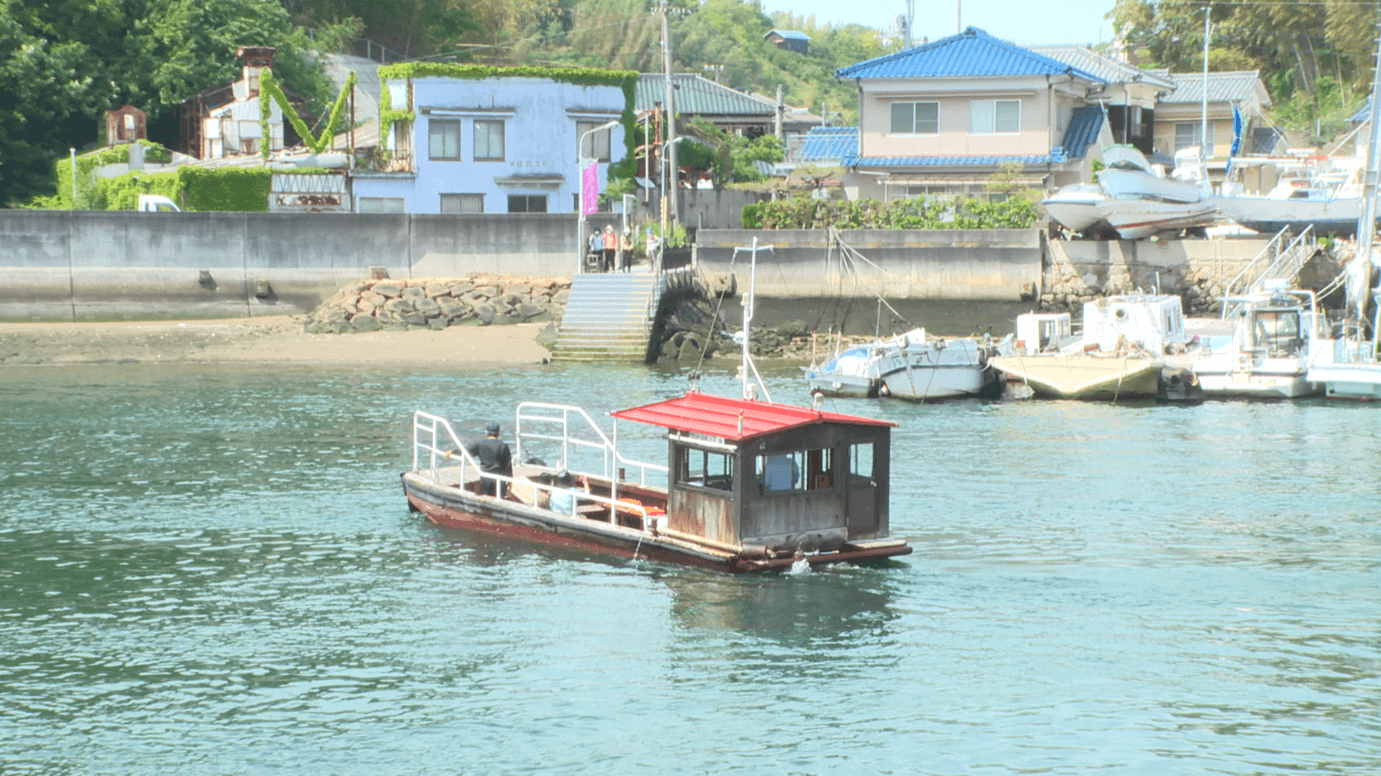
The Mitsu Ferry, managed by Matsuyama City, has been running for over 500 years
We’ve covered much about the land in this series, so in Episode 7 of All About Matsuyama, we’re heading to the sea. Mitsuhama Port sits in the western part of Matsuyama, Ehime. Mitsuhama is a port town that flourished during and following the Edo Period as the ‘front door to the ocean.’ Visiting the town is a trip down memory lane as there are still pseudo Western-style buildings from the Meiji and Taisho periods that suffered damage from the war, as well as traditional Japanese houses, and more. The Mitsuhama Shotengai shopping district was once a bustling place for the fishing and trade industries. Today, buildings have been renovated and taken on new managers who have turned places into stylish cafes, galleries, and other businesses, creating a quaint mix of new and old.
Matsuhama Port is a 15-minute car ride from Matsuyama Station, which itself is connected to other must-visit spots we’ve covered in this series such as Matsuchika Town and Gintengai. If you’re looking for a place to walk around, the port area is somewhere you can really stretch your legs. It’s right outside Mitsu Station from where you can see Mitsuhama Shotengai lined with concrete shops. The street has an old-timey Japanese nostalgic feeling to it. The number of young people frequenting the local shops and houses that have been renovated into various stores is on the rise which is changing its image from a former port town to a hip place to go for shopping. In the summer there are firework festivals and events held by the shopping district, so it’s quickly becoming one of Matsuyama’s new tourist spots.
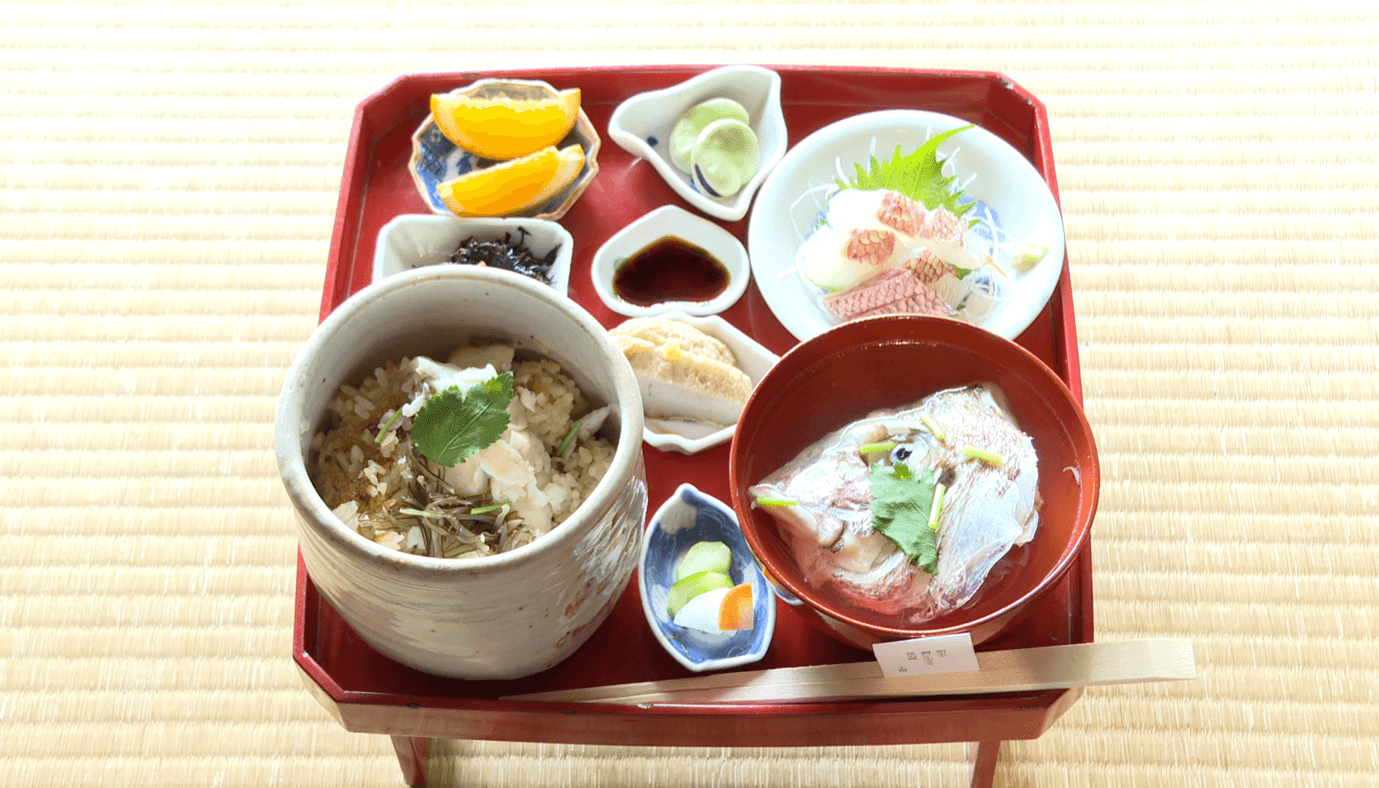
A luxurious sea bream meshi-zen set meal
If you’re strolling through Mitsuhama Shotengai, one place we absolutely want to recommend people visit is Taimeshi, a restaurant that set up shop inside a Japanese house that’s registered as a Tangible Cultural Property. They have only one order on the menu as pictured above: the Taimeshi-Zen, a sea bream set meal, which is made even more enjoyable by the restaurant’s elegant decor.
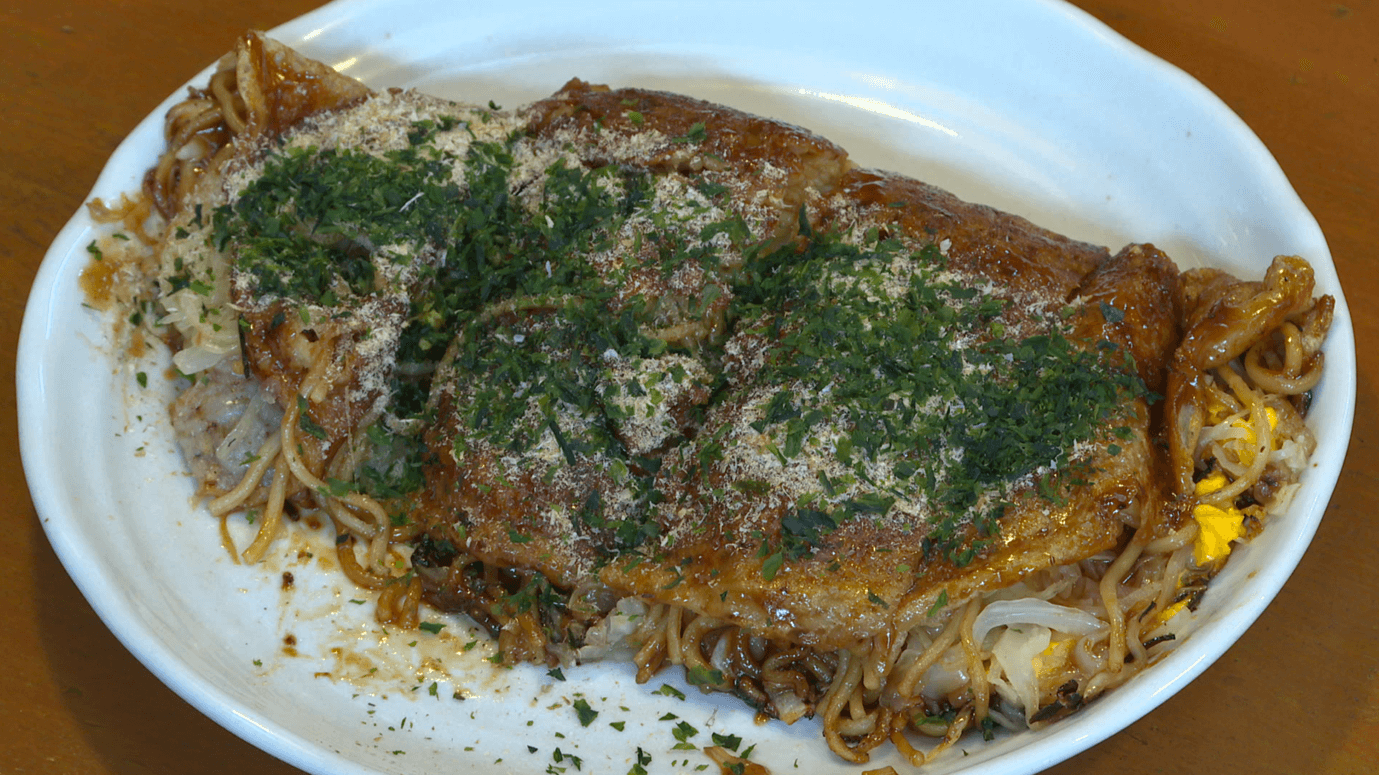
Mitsuyamayaki is a fast food delicacy of Mitsuhama
Everyone needs to try the local fried food as well. The most popular is their okonomiyaki, a common food in Japan. However, the type served in Mitsuhama, known as Mitsuhamayaki, is a little different from the Osaka or Hiroshima styles. They load the batter with noodles and garnish with chikuwa fish-paste, an ingredient long-loved in Mitsuhama, and the secret ingredient—fish flakes. Beef is used as the meat filling. The result is the kind of flavours you’d imagine tucking into in a port down. Each restaurant that serves Mitsuhamayaki serves theirs with their own original sauces too, so no two places will be exactly the same. Try several to compare the tastes.
Something else that can’t be passed up when visiting Mitsuhama is the Mitsu Ferry, a boat with a 500-year history that rides up and down the river and is free of charge. Not only has it been used since the Muromachi Period for transporting goods, it also enjoys 40,000 passengers every year having been recognised as a tourist spot in recent years.
Baishinji Station, which is right next to Minatoyama Station and is how you get to the Mitsu Ferry, is known for being the location of the final episode of the 1991 Japanese drama series Tokyo Love Story. There, visitors can also gaze at the gorgeous view of the Seto Inland Sea, pay a visit to Baishinji Garden to enjoy the plum and cherry blossoms, and more.
Matsuyama is vast and full of many places to enjoy. Mitsuhama is one of these locations and is easily accessed by train from the city centre. It’s a tranquil place where you can feel both the preserved old atmosphere and the modern changes. It’s sure to continue growing as one of the city’s must-visit sightseeing spots.
Information
Taimeshi
Homepage: http://taimesi.net
Address: 1-3-21 Mitsu, Matsuyama, Ehime
味処いとさん
住所 愛媛県松山市住吉2-8-33
-
All About Matsuyama | Episode 6: Feast Your Eyes Upon the City’s Food
The all new Matsuyama Tourist Information Centre is set to open in the heart of Matsuyama—the capital city of Ehime Prefecture in Japan—in Okaido on May 27. In celebration of its opening, this new featured series by MOSHI MOSHI NIPPON will explore the wonders of Matsuyama, a city abundant with places to shop, leisurely hot spots, must-visit restaurants, and opportunities to dive deep into its history and culture. You’re sure to discover something new and exciting about Matsuyama in this series.
One of the biggest attractions to anyone travelling abroad, or even domestically, is the food. In Episode 6 of All About Matsuyama, we give you a mouth-watering tour of Matsuyama’s food scene. Every area of the city is bursting with flavours to be savoured, so here’s our list of places we can’t recommend enough, all located around Okaido Shopping Street, Matsuyama Gintengai, and Matsuchika Town.
Higiriyaki

Higiriyaki is a sweet local treat from Matsuyama with chewy skin and filled with hot adzuki bean paste
The first delectable treat MOSHI MOSHI NIPPON recommends begins at a shop in Okaido Shopping Street. The ‘higariyaki’ is a local food that was first created during the Taisho period in Japan and is also the name of the shop that sells them. It’s said that the first higariyaki was made at Zenshoji Temple which is located in front of Matsuyama Station. The temple is nicknamed “Ohigiri-san,” and the dessert’s name derives from the Higiri Jizo god that is worshiped there. Its dough is made with high quality wheat flour and eggs and is stuffed with an azuki bean paste recipe that has been preserved and passed down since it was first created. You get to see the higiriyaki being made fresh before you when ordering one.
Noma Kajuen noma-noma

Every cup of their refreshing juice is freshly squeezed
Noma Kajuen noma-noma is a juice and gift shop managed by Noma Kajuen, a fruit grower in Ehime which ships tasty mikan oranges around Japan. noma-noma not only serves fresh juice but ice creams, parfaits, drinkable jelly, and other takeout items too – all made with mikan. They have plenty of fruity gifts too, so don’t pass up the opportunity to try some sweet Ehime mikan.
Roken Manto

The only place left making steamed bread with koubokin yeast fungus
Next on the menu is Roken Manto which is famous in Matsuyama for its steamed bread. This bread is made with koubokin yeast fungus and has been since 1931. No preservatives or other additives are used so they don’t have a shelf life – you can only buy and eat them from here. The bread was adapted in Kurashiki from the Chinese steamed bun to cater to Japanese palettes. Fillings include pinto beans, raisins, cheese, cocoa, and more. None are overly sweet so make for a nice easy bite. They are particularly popular with male customers who you often see in droves buying them in the evenings and late into the night.
Nabeyaki Udon Asahi

A bowl of their sweet udon will leave you feeling happy
We’re moving locations now – towards Matsuyama Gintengai. Nabeyaki Udon Asahi is a famous udon bar in Matsuyama known for its sweet tasting nabeyuki udon, something of a soul food to the locals. The restaurant opened in 1947 and has been frequented by locals since. Their udon is simple but delicious, made with a sweet broth, chewy noodles, kamaboko fish paste, chikjuwa fish paste, and boiled egg. The restaurant itself has a retro vibe to it which serves as the perfect setting for your bowl of udon. It will definitely have you wanting a second visit. One thing to note is that the restaurant closes once all noodles have been served, so we recommend visiting in the early afternoon.
Usuzumi Yokan

The quality of the adzuki beans elevate this dessert to sublime new heights
The usuzumi yokan is a famous sweet of Matsuyama which was first made over 1,000 years ago when Empress Jito visited Dogo. Its surface has a sheen to it, and inside are white beans made to look like cherry blossom petals, giving it an extravagant appearance. It’s a sweet famous across Japan having won awards at national confection competitions. You can order them to have-in at this cafe if you like – and their gorgeous Tobe ware plates are available to buy too. Both would be great as souvenirs bought together.
Tonkatsu Katsuyoshi

The crunchy, mouth-watering tonkatsu is nice and light and not fatty at all
Last up on our list takes out to Tonkatsu Katsuyoshi in Matsuchika Town. They serve up some seriously succulent and juicy meat covered in a crunchy layer and served with an in-house sauce. Their menu is long, and all set meals come with a bowl of grated Japanese yam soup. Matsuchika Town is full of popular eateries with lots of takeout items to enjoy, so we recommend visiting there before moving away from the station area.
Matsuyama is loaded with restaurants so you’ll never go hungry. The places on this list, and many others, are waiting for your arrival.
Information
Higiriyaki
Homepage: https://higiriyaki.jp
Address: 2-5-1 Okaido, Matsuyama, Ehime
Noma Kajuen noma-noma
Homepage: https://www.kajuen.co.jp/shop/nomanoma/
Address: 1-4-20 Okaido, Matsuyama, Ehime
Roken Manto
Homepage: http://home.e-catv.ne.jp/takeuchi/
Address: 2-3-15 Okaido, Matsuyama, Ehime
Nabeyaki Udon Asahi
Address: 3-10-11 Minatomachi, Matsuyama, Ehime
Usuzumi Yokan
Homepage: http://www.usuzumi.co.jp
Address: 1-2-2 Okaido, Matsuyama, Ehime
Tonkatsu Katsuyoshi
Homepage: http://matsuchika-town.com/shop/?mode=shop_detail&shop_id=5
Address: Matsuchika Town, 5-1-1 Minatomachi, Matsuyama, Ehime
-
All About Matsuyama | Episode 5: A Shopping Paradise at Every Turn
Five unique shopping districts loved by Matsuyama locals
The all new Matsuyama Tourist Information Centre is set to open in the heart of Matsuyama—the capital city of Ehime Prefecture in Japan—in Okaido on May 27. In celebration of its opening, this new featured series by MOSHI MOSHI NIPPON will explore the wonders of Matsuyama, a city abundant with places to shop, leisurely hot spots, must-visit restaurants, and opportunities to dive deep into its history and culture. You’re sure to discover something new and exciting about Matsuyama in this series.
When visiting Matsuyama, some of the must-visit hot spots include places like Dogo Onsen and Matsuyama Castle. While it’s true you’re sure to enjoy a satisfying sightseeing experience visiting these worthwhile locations, if you’re looking for an even truer Matsuyama experience, you’ll want to hit up the city’s shopping districts. In Episode 5 of All About Matsuyama, we’re looking at five different shopping districts, each with their own unique characters, and all loved by the locals.
The five places we’re looking at are: Okaido Shopping Street, a bustling street and the biggest shopping district in all of Ehime; Matsuyama Gintengai which is lined with a diverse bounty of stores; Matsuchika Town which is the only underground shopping centre in Shikoku; Ropeway Shopping Street, a beautiful street with an inherently ‘Japanese’ feel to it; and Dogo Shotengai which connects the local station to the main Dogo Onsen site. All five of these places should be listed alongside Matsuyama Castle and Dogo Onsen as tourist hot spots.
Let’s begin with Okaido Shopping Street. Located right by Okaido Station, the street runs 483 meters from Shiden Street to Chifunemachi Street. It’s an enormous, brightly-lit arcade with plenty of things to enjoy throughout the day from the morning farm market to the wine and dine experiences to be had in the evenings. No matter the hour, Okaido Shopping Street is bustling, so if you’re looking for some fun in Matsuyama, this is the place.
Next on the list is Matsuyama Gintengai, which runs from Chifunemachi Street to Matsuyama City Station. It connects directly to Okaido Shopping Street and is split into four districts: Sanchome and Yonchome. This 600 meter space is frequented by young and old shoppers alike, with delectable desserts to tuck into and lifestyle items to adorn your days with.
Matsuchika Town can be accessed via an elevator from Matsuyama Gintengai. It’s connected to Matsuyama City Station and is the only underground shopping district you’ll find in the whole of Shikoku, one of the five main islands of Japan. It’s on the smaller side when compared to Okaido and Gintengai, but as well as various stores, it has a well-known rest and meeting spot which is a symbol of the shopping centre.
Ropeway Shopping Street is a 500 meter road that runs from Matsuyama Ichibancho—which is across from the same Shiden Street that links to Okaido Shopping Street—to the Matsuyama Ropeway cable car station that goes to Matsuyama Castle. It’s home to many old-time shops stocking second-hand books, Japanese instruments, and more. It’s also a barrier-free shopping centre which is something of a rarity in Japan.
The final site on this list is Dogo Shotengai, which is about 10-minutes by train from Okaido Station. It’s an L-shaped arcade that runs 250m from Dogo Onsen Station. It’s known colloquially as Dogo High Collar Street for its smart and chic Meiji Roman vibe. There are many people who walk around the area from the surrounding hotels in yukata. It really has that ‘hot spring town’ vibe.
And that’s our list of five unique shopping districts adored by the locals. Be sure to jot them on your list of places to go when travelling to Matsuyama.
Information
Official Site: https://matsuyama-shotengai.com/
-
All About Matsuyama | Episode 4: Japan’s Famous Bathhouses Dogo Onsen & Dogo Onsen Annex Asuka-no-Yu
Dogo Onsen is registered as an Important Cultural Property of Japan

Dogo Onsen Annex Asuka-no-Yu incorporates Asuka Period-style architecture
The all new Matsuyama Tourist Information Centre is set to open in the heart of Matsuyama—the capital city of Ehime Prefecture in Japan—in Okaido on May 27. In celebration of its opening, this new featured series by MOSHI MOSHI NIPPON will explore the wonders of Matsuyama, a city abundant with places to shop, leisurely hot spots, must-visit restaurants, and opportunities to dive deep into its history and culture. You’re sure to discover something new and exciting about Matsuyama in this series.
In Episode 3 of All About Matsuyama, we head to Dogo Onsen, another famous location that should be added to your Matsuyama bucket list adventures.
Dogo Onsen is Japan’s oldest hot spring, located along Dogo Shotengai, a shopping district that runs 250m from Dogo Onsen Station. Dogo Shotengai is known colloquially as Dogo High Collar Street for its smart and chic Meiji Roman vibe. Dogo Onsen is a 3-story hot spring facility in the heart of Dogo which became the first public bathhouse to be registered as an Important Cultural Property of Japan in 1994.
Conservation and repair work began on Dogo Onsen in January 2019 in order to preserve the bathhouse which boasts a long history spanning over 120 years. It is the first public bathhouse in Japan to operate as an Important Cultural Property while undergoing large-scale reparation.
The preservation work is scheduled to take 7 years during which the Dogo Reborn Project is taking place. The Phoenix from Osamu Tezuka’s manga of the same is watching over the revitalization of Dogo Onsen which will be ‘reborn’ like a phoenix. The project is holding a range of events such as light-ups, projection mapping, animations that people can watch, and more.
Please note however that project mapping is temporarily suspended until May 31, 2021 due to COVID-19.
Dogo Onsen’s history spans more than 120 years. Its on-site sister location, Dogo Onsen Annex Asuka-no-Yu, opened in 2017. This bathhouse is constructed in the style of the Asuka Period. Asuka-no-Yu, like the main Dogo Onsen building, is home to Bijin no Yu, a rare kind of water with a soft texture which flows from the source and is neither heated nor cooled.
Dogo Shotengai, which links together Dogo Onsen and Dogo Onsen Annex Asuka-no-Yu, is an L-shaped arcade and runs from Dogo Onsen Station. It has a roof which means you can walk from the station straight to the bathhouse without getting wet on a rainy day. There are around 60 shops to look around, and if you wear a yukata, you’re sure to enjoy the real Dogo experience. Head back in time in Japanese history with a visit to the Dogo area.
Information
Dogo Onsen Homepage (English): https://dogo.jp/en/
Address: 5-6 Dōgoyunomachi, Matsuyama, Ehime 790-0842, Japan
Access: 5-minutes on foot from Dogo Onsen Station
-
All About Matsuyama | Episode 3: Matsuyama Castle’s History Overlooking the City Throughout History
Matsuyama Castle from high above
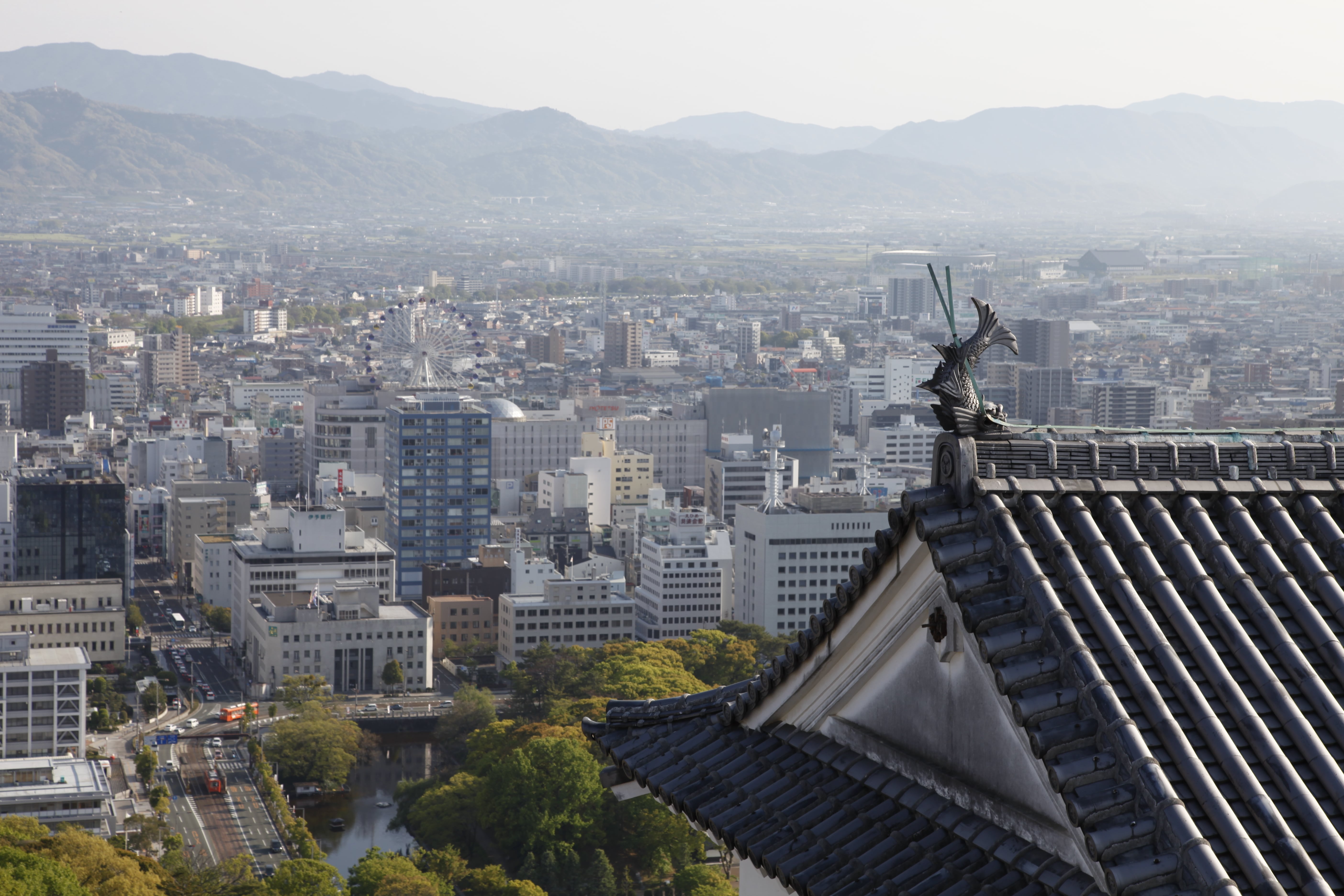
Matsuyama’s shitamachi castle town
The all new Matsuyama Tourist Information Centre is set to open in the heart of Matsuyama—the capital city of Ehime Prefecture in Japan—in Okaido on May 27. In celebration of its opening, this new featured series by MOSHI MOSHI NIPPON will explore the wonders of Matsuyama, a city abundant with places to shop, leisurely hot spots, must-visit restaurants, and opportunities to dive deep into its history and culture. You’re sure to discover something new and exciting about Matsuyama in this series.
In Episode 3 of All About Matsuyama, we’re taking a look at Matsuyama Castle, an absolutely indispensable location when travelling to Matsuyama which has and still watches over the development surrounding shitamachi castle town.
Matsuyama Castle sits at the heart of Matsuyama. It was built in 1603 on top of Mount Katsuyama which stands towering at 132 meters tall. At the foot of the mountain are two enclosures: Ninomaru and Sannomaru. The castle grounds are so big that you wouldn’t be able to see everything in a single day. It’s also home to only one of 12 existing original castle towers in Japan, is featured in Japan’s Top 100 Castles list, and was selected as one of the 100 Most Beautiful Historical Sites in Japan. It also ranked as the third best castle in Japan in a 2020 list. You clearly can’t pass up a visit to Matsuyama Castle when travelling to Matsuyama!
There are several ways to get to Matsuyama Castle. You can take the walking route upwards which takes about 30 minutes, but many people take the Ropeway or lift. You can buy a ticket for the Ropeway at the station outside Matsuyama Ropeway Shopping District. You will be greeted by Matsuyama Castle’s mascot character Yoshiaki-kun.
Matsuyama Castle was built following the Battle of Sekigahara by Katō Yoshiaki who was awarded for his service as a retainer of Toyotomi Hideyoshi. The main tower is the only part that has been preserved in its original form. Other parts of the keep have been restored throughout the years due to fires. Several parts of the castle have been designated as Important Cultural Properties including the main tower which can be accessed by visitors who can see what the castle was like when it was first built.
The castle is surrounded by a towering 14-meter stone wall which, though was built in order to prevent enemies from infiltrating, has an air of beauty to it. Two stone walls were built on the mountain slope to stop people from entering via the hillside too. This wall is considered a nationally precious example of Japanese history and is a must-see when visiting Matsuyama Castle.
It’s rare for a castle like this in the middle of a city to have such a history. The view from the very top of the castle keep, which is an extra 30 meters on top of the 132m tower, is a wonderful sight to behold as you gaze across Matsuyama. Many people visit the castle during the daytime, but the castle is actually one of the city’s most beautiful night time spots too. Whichever time of the day you decide to visit, you’re sure to learn much about Matsuyama’s history.
Information
Due to COVID-19, the castle, Ropeway Lift, and Ninomaru Gardens are temporarily closed until May 31, 2021.
Matsuyama Castle Homepage: https://www.matsuyamajo.jp
Matsuyama Castle Ropeway is a 5-minute walk from Okaido Station.
-
All About Matsuyama | Episode 2: Bargain Shopping Experience With machipay
The all new Matsuyama Tourist Information Centre is set to open in the heart of Matsuyama—the capital city of Ehime Prefecture in Japan— in Okaido on May 27. In celebration of its opening, this new featured series by MOSHI MOSHI NIPPON will explore the wonders of Matsuyama, a city abundant with places to shop, leisurely hot spots, must-visit restaurants, and opportunities to dive deep into its history and culture. You’re sure to discover something new and exciting about Matsuyama in this series.

Machia in Matsuyama Gintengai offers support for the machipay Service
In Episode 2 of All About Matsuyama, we’re looking at ‘machipay,’ a special service exclusive to Matsuyama that opens opportunities for a great value shopping experience.
Matsuyama’s shopping districts serve as the foundation of the lives of those residing in Matsuyama. Even visiting as a tourist for shopping and sightseeing you can enjoy an inherently ‘Matsuyama’ experience. Something that will make that experience even better is using the city’s machipay service which combines points, electronic money, and coupons all in one place. The service was created for both locals living in the city as well as tourists to create a more convenient shopping experience.
The machipay card and app feature three functions: Points, Electronic Money, and Shopping Coupons. It is compatible at countless popular stores around Matsuyama including Okaido, Gintengai, Matsuchika Town, Matsuyama Ropeway Shopping Street, and elsewhere. Every ¥100 of electronic money spent using the service nets you one point, and one point is equivalent to ¥1. Putting money on the card and paying with it means you’ll start collecting lots of points which can be used at these various stores. Coupons offered around the shopping districts and its stores can also be saved onto your machipay app, making it a very handy shopping companion.
But shopping isn’t the only way to earn machipay points. Attending events in the city, getting involved in voluntary work, and other activities that involve living in or like the people of Matsuyama will also garner you points.
The “machica Card” which is used for the service is sold at the machia shop (pictured above) in Matsuyama Gintengai everyday from 10:00-19:00. There’s also an app. As of April 30, 2021, there are 1,200 stores in Matsuyama that are participating in the service.
If you’re planning a trip to Matsuyama, make sure to use machipay.
Information
machipay
Contact machipay: 0570-055-081
machica shop Address: 3-7-10 Minatomachi, Matsuyama, Ehime 790-0012, Japan
machia Official Website: https://machica.jp


